

Waiting for the Other Shoe to Drop, February 12, 2017
 |
||
| Hmong refugees in Ban Vinai, the first camp we worked in | ||
 |
||
| Cambodian refugees in PRPC, in the Philippines | ||
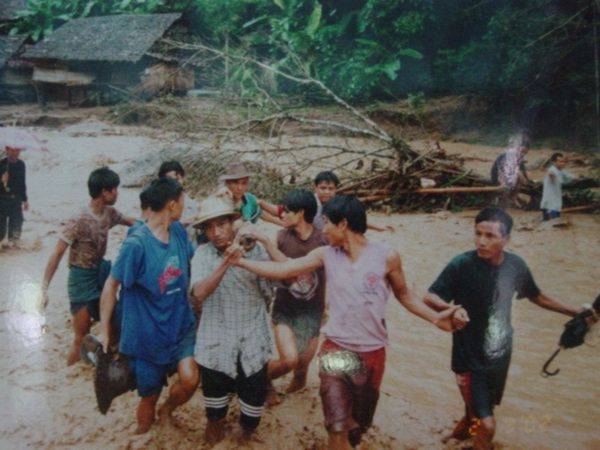 |
||
| Burmese refugees on trhe Thai border | ||
In 1996, we wrote an essay relating the Maha-Supina Jataka, "The Sixteen Dreams" to the situation in Burma. In that tale, the Buddha told King Pasenadi that his frightening and mysterious dreams foretold a time when kings would be greedy and unjust, foolish and unqualified people would be given authority, educated people would lose their positions, judges would be corrupt, and religious leaders would be concerned only with their own prosperity and power. We had seen paintings of the dreams in several temples in Burma and had heard that Burmese were making the connection.
 We were not wrong, of course, to apply the story to Burma, but we hadn't grasped the full import of the Buddha's tale; we'd seen it only in a limited context. It is now apparent that through King Pasenadi's dreams the Buddha was foretelling the present situation in which virtue everywhere is waning and the world has fallen into decay. Those dreams can be interpreted in terms of the dire political, social, and environmental conditions of the whole planet. With climate catastrophe looming, financial meltdowns pending, nuclear disasters threatening, the energy crisis, dominance by lawless international corporations, with flagrant corruption on every side, and the reality of endless wars, no one is immune. We are all vulnerable and all life on the planet at risk. In the modern world, the proliferation of greed, hatred and delusion is accelerating so fast that it is impossible to keep up. We cannot continue to view what is unfolding around us in a detached way anymore. It is personal, it applies to all, it affects us all, even the wealthiest, the most powerful, the elite. As usual, however, those first affected are those least responsible and the least able to help themselves.
We were not wrong, of course, to apply the story to Burma, but we hadn't grasped the full import of the Buddha's tale; we'd seen it only in a limited context. It is now apparent that through King Pasenadi's dreams the Buddha was foretelling the present situation in which virtue everywhere is waning and the world has fallen into decay. Those dreams can be interpreted in terms of the dire political, social, and environmental conditions of the whole planet. With climate catastrophe looming, financial meltdowns pending, nuclear disasters threatening, the energy crisis, dominance by lawless international corporations, with flagrant corruption on every side, and the reality of endless wars, no one is immune. We are all vulnerable and all life on the planet at risk. In the modern world, the proliferation of greed, hatred and delusion is accelerating so fast that it is impossible to keep up. We cannot continue to view what is unfolding around us in a detached way anymore. It is personal, it applies to all, it affects us all, even the wealthiest, the most powerful, the elite. As usual, however, those first affected are those least responsible and the least able to help themselves.
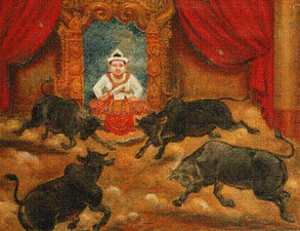 In the first dream, four jet-black bulls came together to fight, but they only made a show of fighting, pawing and bellowing. Finally, they went off, without fighting at all. The Buddha told the king that the four black bulls represented dark clouds which appeared to be full of rain, but were, in reality, impotent. He explained that, as good was waning and evil waxing, the world would be perverted, and kings would become stingy and citizens unrighteous. At that time, no rain would fall from the heavens, the monsoons would forget their season, the crops would wither, and famine would stalk the land. In 2016, there were drought conditions on every continent. Most seriously affected areas included Ethiopia, Somalia, Cambodia, Vietnam, the Philippines, India, California, Chile, and Brazil. The eastern Mediterranean suffered its worst drought in 900 years.
In the first dream, four jet-black bulls came together to fight, but they only made a show of fighting, pawing and bellowing. Finally, they went off, without fighting at all. The Buddha told the king that the four black bulls represented dark clouds which appeared to be full of rain, but were, in reality, impotent. He explained that, as good was waning and evil waxing, the world would be perverted, and kings would become stingy and citizens unrighteous. At that time, no rain would fall from the heavens, the monsoons would forget their season, the crops would wither, and famine would stalk the land. In 2016, there were drought conditions on every continent. Most seriously affected areas included Ethiopia, Somalia, Cambodia, Vietnam, the Philippines, India, California, Chile, and Brazil. The eastern Mediterranean suffered its worst drought in 900 years.
In the fourth dream, strong, healthy oxen were unyoked and replaced by puny, immature young steers, too weak to move the load. The Buddha explained that unjust and parsimonious kings, rather than honoring experienced and learned judges, would appoint foolish, inexperienced, and unprincipled young men to the courts. Because of their incompetence, these judges would fail.
 In the fifth dream, a horse with a mouth on each side of its head was being fed fodder on both sides and ate voraciously with both its mouths. The Buddha explained that unrighteous and irresponsible kings would appoint as judges covetous men who, blind to virtue and honesty, would take bribes from both sides as they sat in judgment.
In the fifth dream, a horse with a mouth on each side of its head was being fed fodder on both sides and ate voraciously with both its mouths. The Buddha explained that unrighteous and irresponsible kings would appoint as judges covetous men who, blind to virtue and honesty, would take bribes from both sides as they sat in judgment.
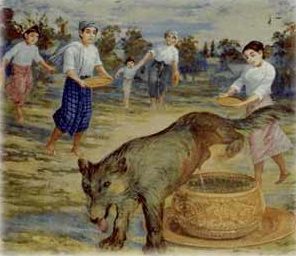 In the sixth dream, people were holding a golden bowl for a mangy jackal to urinate into. The Buddha explained that, as the world went into decline, leaders would give important positions to incompetent people, the dregs of society, the worst of the worst.
In the sixth dream, people were holding a golden bowl for a mangy jackal to urinate into. The Buddha explained that, as the world went into decline, leaders would give important positions to incompetent people, the dregs of society, the worst of the worst.
In the eighth dream, a big pitcher, full to the brim, stood at a palace gate. Around it, were many empty pitchers. Coming from all directions, a steady stream of people poured more water into the already full pitcher, which overflowed wastefully. Not a single person even glanced at the empty pitchers. The Buddha explained that this foretold a time when the leaders would force citizens to neglect their own work and to labor only for the throne. Today, eight white males, who represent corporate capitalism, possess the same amount of wealth as the poorest 50 percent of the world's population. How many millions of people are working as slaves or for starvation wages in factories, mines, and sweatshops, not to mentions the homeless or hungry?
 In the ninth dream, animals came from all directions to drink water from a deep pool with sloping banks and overgrown with lotuses. Strangely, the deep water in the middle was muddy, but the water at the edges, where all those thirsty creatures had descended into the pool, was clear and sparkling. The Buddha explained that, someday, corrupt leaders would oppress their subjects so mercilessly that they would all flee to the borders. The heart of the country would become a wilderness, while the borders would teem with refugees. In June 2016, the United Nations reported that 65 million people were forced to flee their homes, the most ever recorded.
In the ninth dream, animals came from all directions to drink water from a deep pool with sloping banks and overgrown with lotuses. Strangely, the deep water in the middle was muddy, but the water at the edges, where all those thirsty creatures had descended into the pool, was clear and sparkling. The Buddha explained that, someday, corrupt leaders would oppress their subjects so mercilessly that they would all flee to the borders. The heart of the country would become a wilderness, while the borders would teem with refugees. In June 2016, the United Nations reported that 65 million people were forced to flee their homes, the most ever recorded.
In the tenth dream, a pot of rice was not cooking normally. The rice seemed to be separated into three sections. One part of the rice was sodden, another part was hard and raw, but the third part was perfectly cooked. The Buddha explained that, as the world declined, leaders would become unrighteous, and citizens of every class would follow their example. When this happened, the devas would disrupt the weather so that, even though the weather was good in one place, a heavy downpour would damage the crops in another, and the crops would wither from drought in a third. Does this correspond to global warming and climate catastrophe? 2016 was the hottest year ever recorded, but, in November, there was both snowfall and flooding in the deserts of Saudi Arabia.
In the eleventh dream, rancid buttermilk was being bartered for precious sandalwood. The Buddha explained that greedy and shameless bhikkhus would, one day. use fine words and sweet voices to induce lay followers to give them costly robes, delicate food, luxurious items, and money. Their preaching would not lead to Nibbana. How many monks today are amassing enormous bank accounts, collecting luxury vehicles, and earning money by selling amulets and telling fortunes? Mindfulness meditation, which is the cornerstone of Buddhist practice, is being peddled to enhance productivity in a consumer world, where everything has a price.
In the twelfth and thirteenth dreams, empty gourds sank in the water, and huge rocks floated. The Buddha explained that this foretold a time when uneducated fools would be established in positions of authority and reputable advisors would fade into obscurity. Bring in the clowns!
 In the final dream, goats chased and ate wolves. The terror-stricken wolves fled and hid in thickets. The Buddha explained that when the uneducated were raised to important posts, they would gain enough power to demand respect. The reputable and wise would be so beaten down that they would meekly give up their authority and agree that black was white. Today, lies are being repeated so often that they are being accepted as the truth, and the media are asked to believe "alternative facts."
In the final dream, goats chased and ate wolves. The terror-stricken wolves fled and hid in thickets. The Buddha explained that when the uneducated were raised to important posts, they would gain enough power to demand respect. The reputable and wise would be so beaten down that they would meekly give up their authority and agree that black was white. Today, lies are being repeated so often that they are being accepted as the truth, and the media are asked to believe "alternative facts."
In a telling analysis of the American situation, Barbara O'Brien posted on her Mahablog that Donald Trump is actually an asura, a jealous, insecure, greedy, and miserable being.
Overriding emotions seem to be fear and helplessness. Our world is facing one of the most serious challenges in human history, namely climate catastrophe, with an asylum of lunatics, stinking rich elite, who refuse to admit that the problem exists.
When you get a message like this from a young professional you've known since she was in high school, you fear for the country.
|
Bloody hell. It's a done deal. Pulled kids out of school early to watch inauguration. 4 years to survive through, ahead of us. Pray over our country, you guys. (I always feel like you are more powerful pray-ers than us average normal people.) Love you! |
|||
A useful antidote to despair is meditation on death.
|
|
How are we to live in the interim?

It felt good to throw ourselves into preparations for the Bangalore Intensive--writing passages for Step by Step, our new controlled composition textbook; organizing activities and logic puzzles; checking Merit, lesson by lesson; and selecting Dhammapada and Jataka stories for a reader. After compiling the four books, we revised, proofread, corrected, and printed them multiple times until we were satisfied. Finally, about a week before we left, we sent the files to MahaBodhi Society for printing. We also cut and folded twenty sets of Buddhist Knowledge Quest and printed and cut many sets of Go Fish!, Concentration, and Dhammapada Search. All of these materials went into one suitcase, along with all the teaching aids necessary for Merit lessons, a total of fifteen kilos. Thank goodness that Sri Lankan Airlines allows thirty kilos of baggage per ticket and that we get extra kilos for our Amex credit card!
Having completed all this printing, our Canon laser printer started acting up, and finally died. The day before we left, we took it to a nearby shop and asked them to repair it if the cost was reasonable. (On our return from India, we learned that repair would cost more than 10,000 rupees ($66) and that a new and better printer costs 30,000 rupees ($200). We opted for the new one, a Samsung. The neatest feature is that it will automatically print an A4 page poster-size on 16 sheets of paper. This is ideal for activities such as a logic puzzle when you want to have a class work together on filling in a matrix. Manually cropping and printing this with a photo program has taken hours. Now it can be done in two minutes! Hooray!)
 |
||
| Nezumi sleeping in the sun | ||
Bihar should be cold, but, on our last pilgrimage, it wasn't. Bangalore is in the south, so it should be fairly warm, but there is no longer any "normal." We knew we had left some heavy clothes in Kolkata, but we could not remember what they were.
Finally, in the morning of November 24, along with Ewen, we loaded all the luggage into Tissa's van and headed for the airport. We were able to have a leisurely lunch in Ambepussa and arrive at the airport with plenty of time. Check-in was a breeze -- no overweight and everything in order. With Visakha comfortably in a wheelchair, we headed for Immigration (Emigration?) We waited while Ewen handed his passport to the official. We didn't hear a ZAP!, but, at that moment, the whole system went down.
All the officials left their desks and huddled together to discuss the situation. The hall rapidly filled with travelers, patiently standing in queues. The uniformed guards stopped letting people enter, and we watched the lines outside growing by the hundreds. Nearby, we noticed one young man with a T-shirt announcing, "I am a Cyber-Activist," and Ken asked him what that meant. With a smile, he explained that a cyber-activist was one who uses the internet to achieve social change. A little later, Ken noticed him sitting on a couch near the entrance. A little behind his place in line was an older man with a cane, who appeared very uncomfortable standing. Ken pointed him out to the cyber-activist, who offered his seat, thanked Ken, and returned to his place in line. After about one hour of inactivity, the officials started passing out forms which we quickly filled out with pens. The forms were accepted, our passports were stamped, and we boarded the plane. Amazingly, we took off right on time.
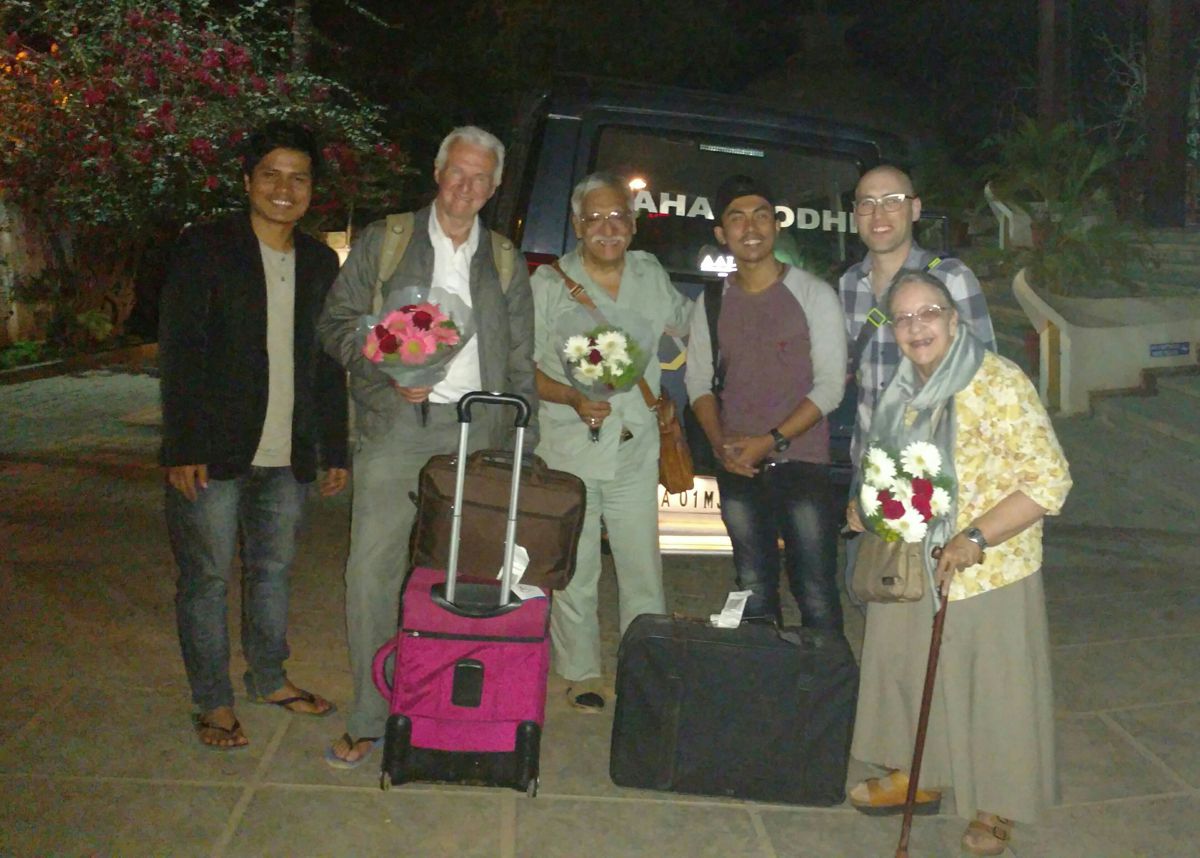 We wondered how we would recognize anyone from Mahabodhi, but right in front of the exit was Josh, with a big smile, waving. He had arrived in Bangalore a week before. No sooner had we stepped out than two young Indian men took our luggage carts and handed each of us a bouquet of flowers. We were grateful to Josh for supplying us with a bit of Indian currency to give the wheelchair attendant a tip. Because of Modi's recent demonetization, it was virtually impossible (for the month in Bangalore) to change money or to find an ATM with any cash. Luckily, we were not much affected because the Mahabodhi Society took care of everything for us, and we could use our credit cards almost everywhere in town.
We wondered how we would recognize anyone from Mahabodhi, but right in front of the exit was Josh, with a big smile, waving. He had arrived in Bangalore a week before. No sooner had we stepped out than two young Indian men took our luggage carts and handed each of us a bouquet of flowers. We were grateful to Josh for supplying us with a bit of Indian currency to give the wheelchair attendant a tip. Because of Modi's recent demonetization, it was virtually impossible (for the month in Bangalore) to change money or to find an ATM with any cash. Luckily, we were not much affected because the Mahabodhi Society took care of everything for us, and we could use our credit cards almost everywhere in town.
Lots of other people, however--ordinary folks, farmers, and small traders--had their lives turned upside-down. But, these days, politicians don't seem to give a damn about who they hurt, so long as their rich friends make a profit.
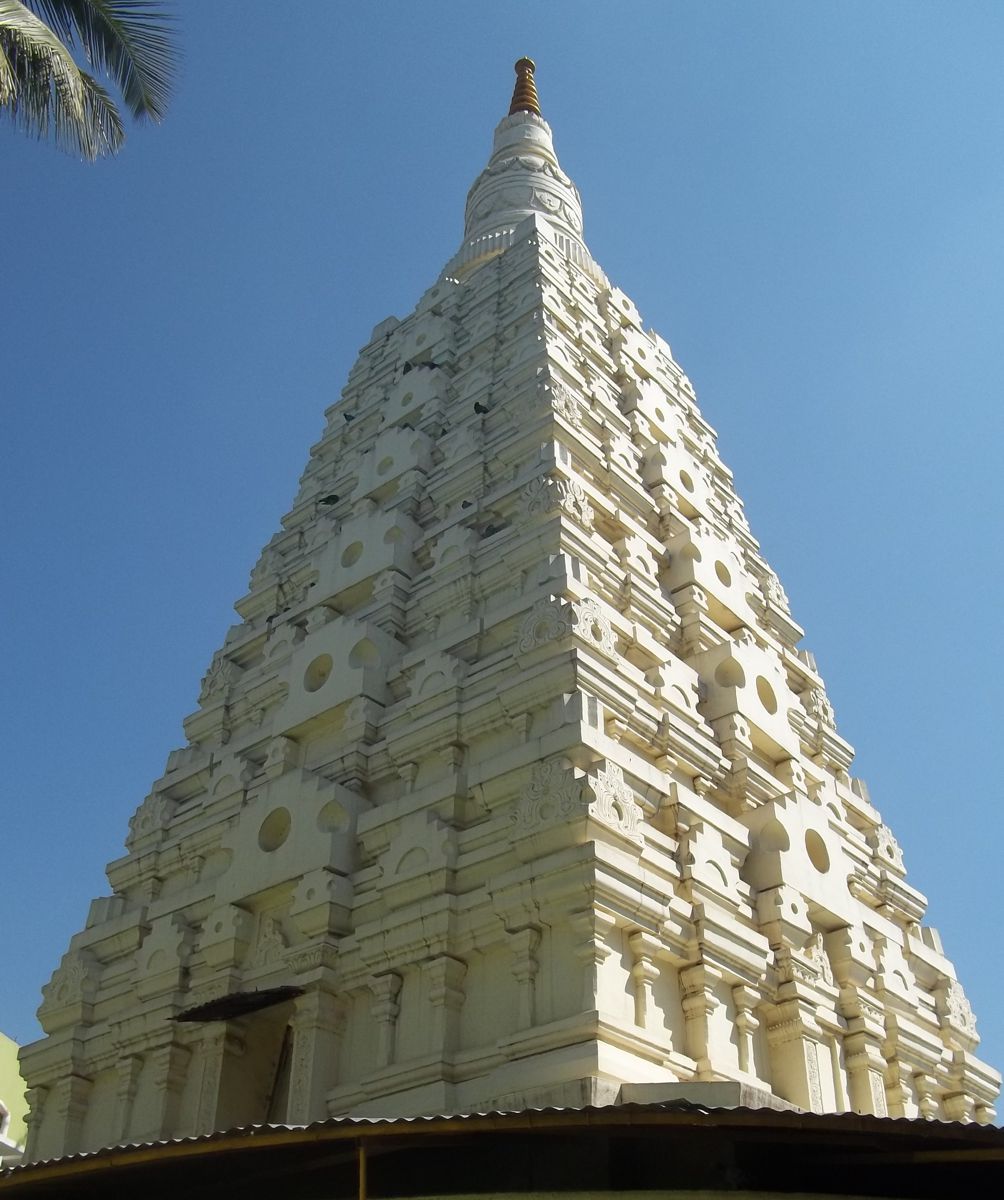 The Mahabodhi Society compound is a multi-level, three-dimensional labyrinth. The main entrance, with an attendant always on duty, is an imposing Sanchi-type gateway. Beside this is a small hidden gate that leads to the stairs of the bookshop, whose entrance is outside the compound. The gateway opens on a paved courtyard which is sometimes occupied by several vehicles. Directly in front is the shrine and meditation hall, which is about eight steps up and crowned with a replica of the spire of the MahaBodhi Vihara in BuddhaGaya. This hall seats about two hundred people. In the basement of this building is a small museum dedicated to Ven. Acharya Buddharakkhita's life and work, and huge community hall with a proscenium stage. To the left of the meditation hall is a garden with a magnificent bodhi tree, two stupas, a footprint mandap, a shrine with a bronze image of the founder, and meditation walks. Walking through the garden, one comes to the original shrine room, above which are the original meditation hall and the residences of the senior monks. (On that level, at the end of a dark corridor, you can find, if you are lucky, a secret washing machine.) To the right of the meditation hall (back at the main gate) is a short staircase leading to the offices. On the third floor (eleven steps between each floor) of this building, above the offices, is a bridge to another building with classrooms in the center and an open corridor on three sides. Through a locked door you can see a spiral staircase, but no one seemed to know where it led. Back on the office level, a half-covered alley beside another open corridor ends at a staircase. One can go up to the guest rooms, above which is a spacious assembly hall, or down to a narrow courtyard behind the meditation hall, where the novices gather for their (noisy) afternoon tournament of carrom.
The Mahabodhi Society compound is a multi-level, three-dimensional labyrinth. The main entrance, with an attendant always on duty, is an imposing Sanchi-type gateway. Beside this is a small hidden gate that leads to the stairs of the bookshop, whose entrance is outside the compound. The gateway opens on a paved courtyard which is sometimes occupied by several vehicles. Directly in front is the shrine and meditation hall, which is about eight steps up and crowned with a replica of the spire of the MahaBodhi Vihara in BuddhaGaya. This hall seats about two hundred people. In the basement of this building is a small museum dedicated to Ven. Acharya Buddharakkhita's life and work, and huge community hall with a proscenium stage. To the left of the meditation hall is a garden with a magnificent bodhi tree, two stupas, a footprint mandap, a shrine with a bronze image of the founder, and meditation walks. Walking through the garden, one comes to the original shrine room, above which are the original meditation hall and the residences of the senior monks. (On that level, at the end of a dark corridor, you can find, if you are lucky, a secret washing machine.) To the right of the meditation hall (back at the main gate) is a short staircase leading to the offices. On the third floor (eleven steps between each floor) of this building, above the offices, is a bridge to another building with classrooms in the center and an open corridor on three sides. Through a locked door you can see a spiral staircase, but no one seemed to know where it led. Back on the office level, a half-covered alley beside another open corridor ends at a staircase. One can go up to the guest rooms, above which is a spacious assembly hall, or down to a narrow courtyard behind the meditation hall, where the novices gather for their (noisy) afternoon tournament of carrom. 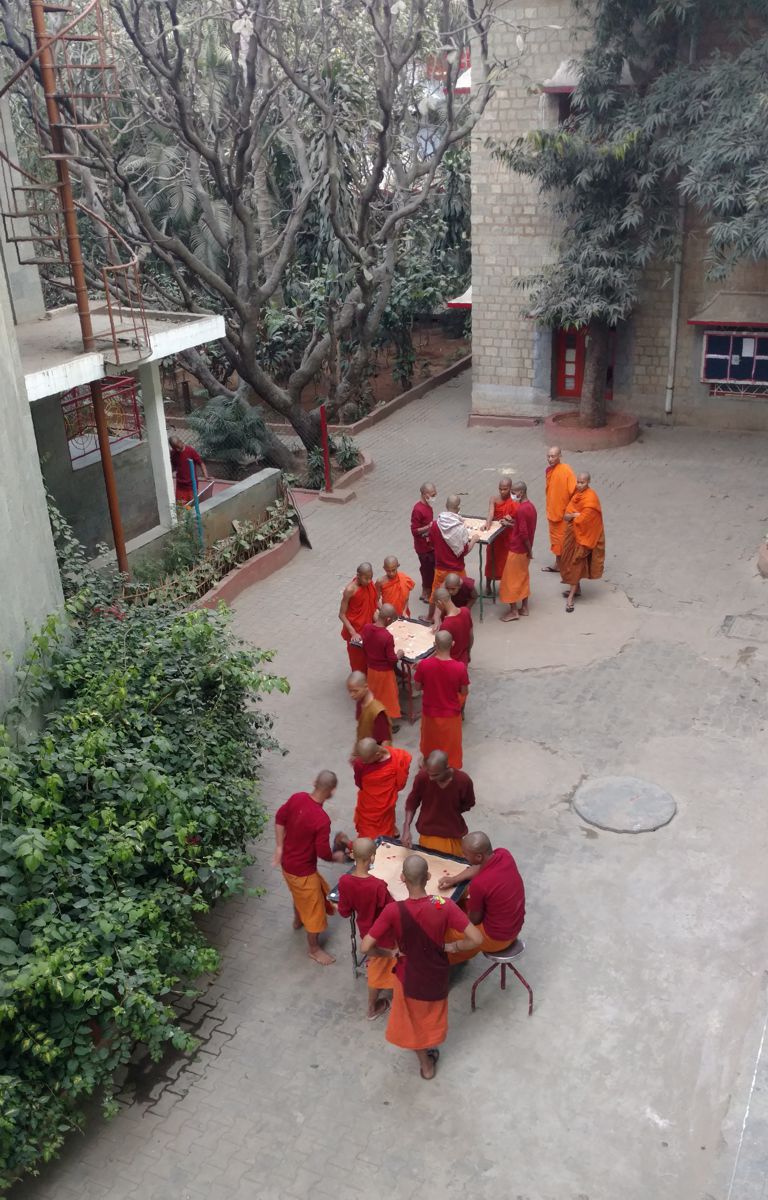 On the guestroom level, a door on the right leads to a dark hallway with several staff residence rooms. This hallway opens onto a balcony built around a tree. From there, a spooky staircase leads to a secret exit onto a side street. On the other side of the balcony, there are more staff residence rooms, which are below the classrooms, but seemingly inaccessible therefrom. On ground level, across the narrow courtyard, is the kitchen and pantry. A narrow alley goes between the (original) shrine room on one side and the kitchen and the dining hall on the other. The only entrance to the dining hall is at the end of the alley, on the far side of the shrine room. Another staircase there leads to the novices' dormitories above the dining hall. The corridor of the dormitories ends at a small balcony, from which one staircase goes down to the kitchen and another short staircase goes up to the guestrooms. It took a full month to understand where all the stairs and corridors led. Someone understood it all, for lining every corridor were beautiful potted plants, which were regularly watered. At the top of the bridge there was a plant with what started as a bud and turned into a beautiful white flower, like a jack-in-the-pulpit, by the end of the course.
On the guestroom level, a door on the right leads to a dark hallway with several staff residence rooms. This hallway opens onto a balcony built around a tree. From there, a spooky staircase leads to a secret exit onto a side street. On the other side of the balcony, there are more staff residence rooms, which are below the classrooms, but seemingly inaccessible therefrom. On ground level, across the narrow courtyard, is the kitchen and pantry. A narrow alley goes between the (original) shrine room on one side and the kitchen and the dining hall on the other. The only entrance to the dining hall is at the end of the alley, on the far side of the shrine room. Another staircase there leads to the novices' dormitories above the dining hall. The corridor of the dormitories ends at a small balcony, from which one staircase goes down to the kitchen and another short staircase goes up to the guestrooms. It took a full month to understand where all the stairs and corridors led. Someone understood it all, for lining every corridor were beautiful potted plants, which were regularly watered. At the top of the bridge there was a plant with what started as a bud and turned into a beautiful white flower, like a jack-in-the-pulpit, by the end of the course.
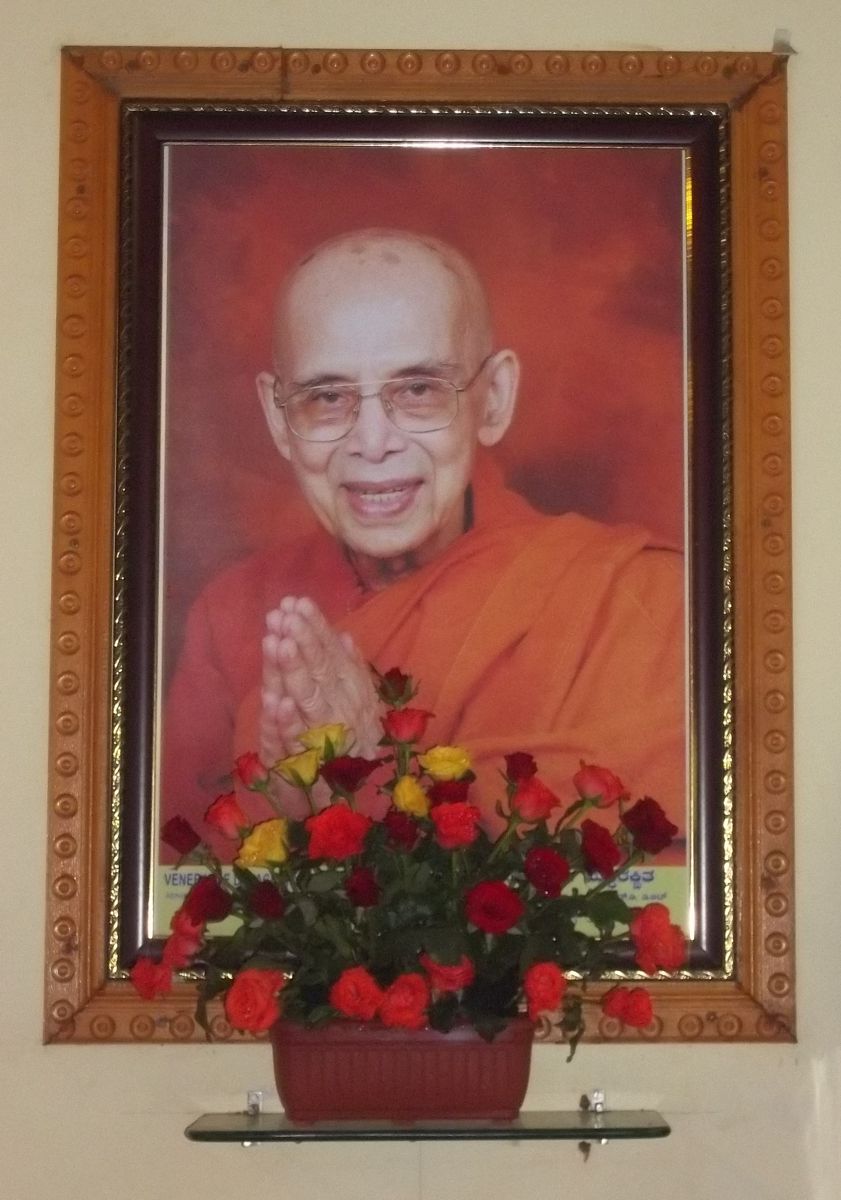 |
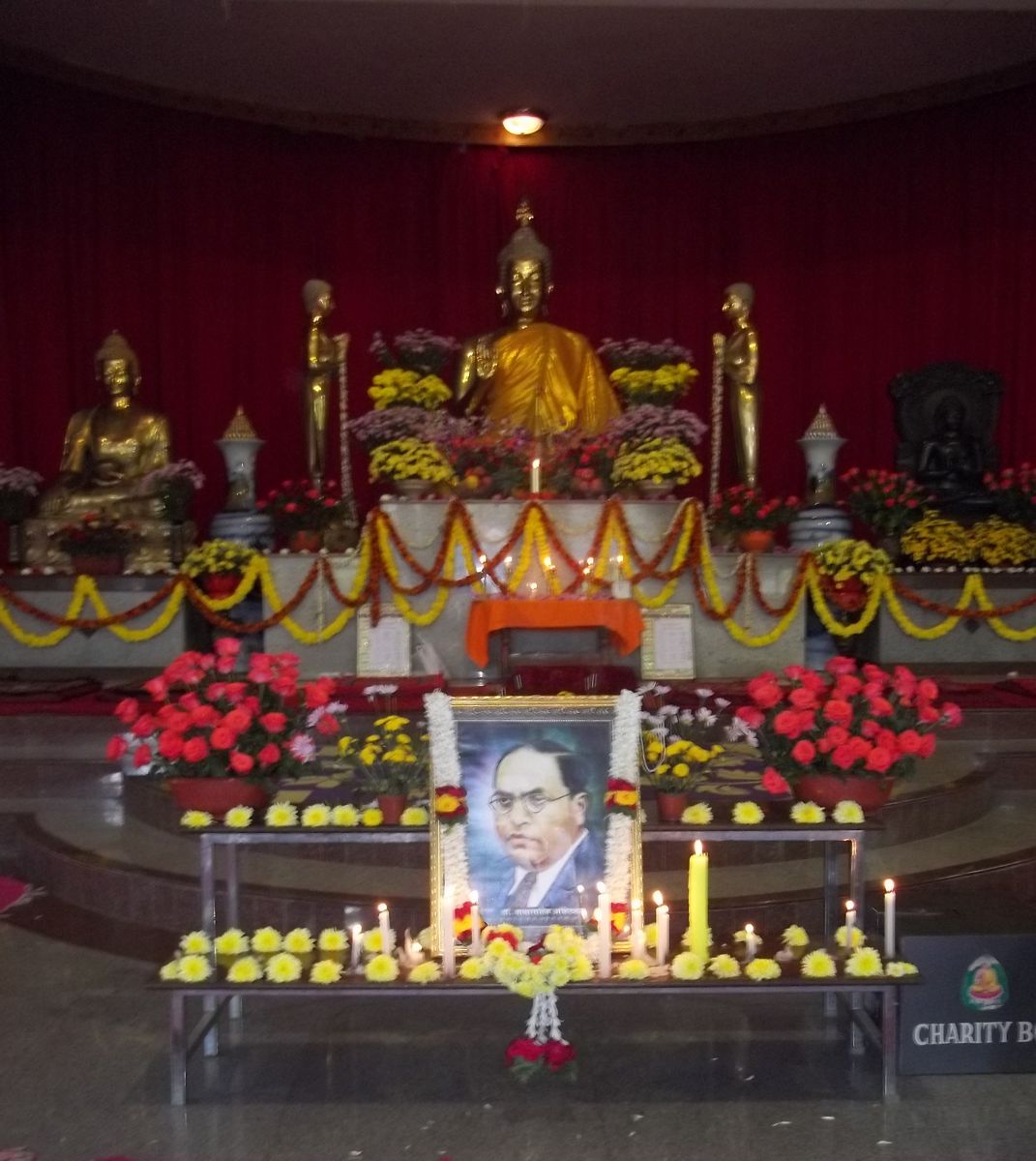 |
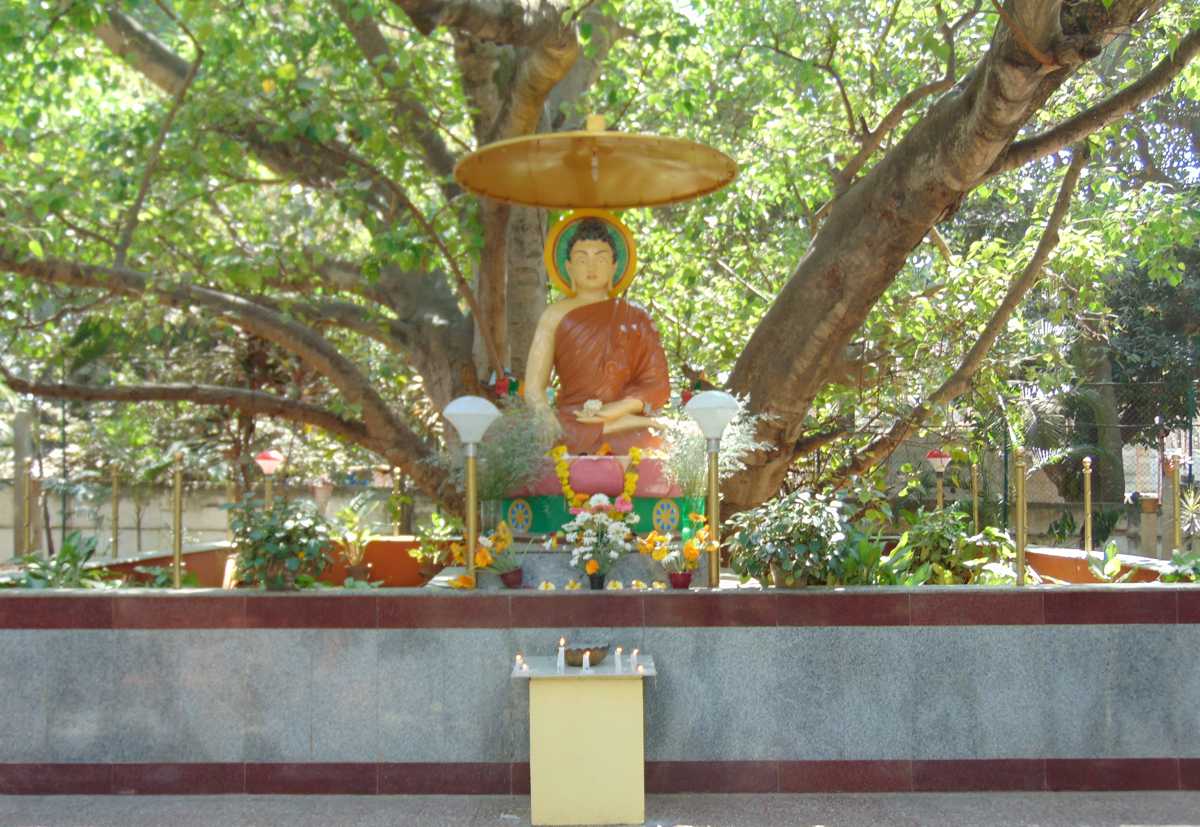 |
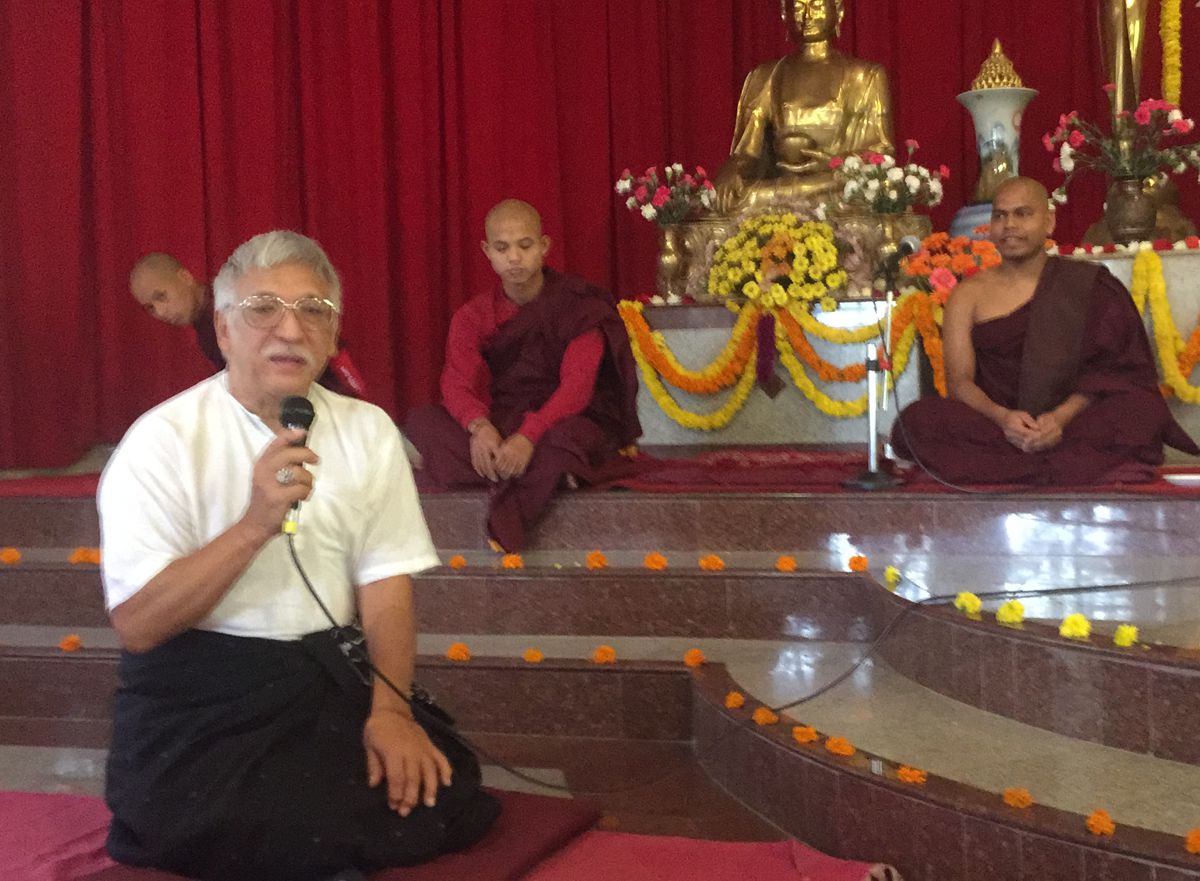 |
|
 When we arrived, Ven. Ananda, with whom we had originally arranged to hold the First Bangalore Intensive Buddhist English Course, to give it its official title, was in Germany. He had assigned Ven. Buddhadatta, the headmaster of the school, to take charge of the course. Our placement survey was scheduled for Saturday. Thus, Steve (who has taught with us at Bodhisukha), Judith, (his friend and an artist), who had arrived just hours before us, Ewen, Josh, and we were busy Saturday evening and all day Sunday, reviewing the surveys and dividing the students into five classes, which we named after the colors of the Buddhist flag--red, white, blue, yellow, and orange. We arranged the schedule so that all the teachers rotated among the classes. Everyone taught every class, which meant that each student experienced each teacher's method. When we learned that Daniel would not be arriving until the end of the second week, we combined two small classes so that each teacher would have a free period once in a while. We asked the students of the new class whether they would like to be called red and white or pink. They unanimously voted for the former.
When we arrived, Ven. Ananda, with whom we had originally arranged to hold the First Bangalore Intensive Buddhist English Course, to give it its official title, was in Germany. He had assigned Ven. Buddhadatta, the headmaster of the school, to take charge of the course. Our placement survey was scheduled for Saturday. Thus, Steve (who has taught with us at Bodhisukha), Judith, (his friend and an artist), who had arrived just hours before us, Ewen, Josh, and we were busy Saturday evening and all day Sunday, reviewing the surveys and dividing the students into five classes, which we named after the colors of the Buddhist flag--red, white, blue, yellow, and orange. We arranged the schedule so that all the teachers rotated among the classes. Everyone taught every class, which meant that each student experienced each teacher's method. When we learned that Daniel would not be arriving until the end of the second week, we combined two small classes so that each teacher would have a free period once in a while. We asked the students of the new class whether they would like to be called red and white or pink. They unanimously voted for the former.
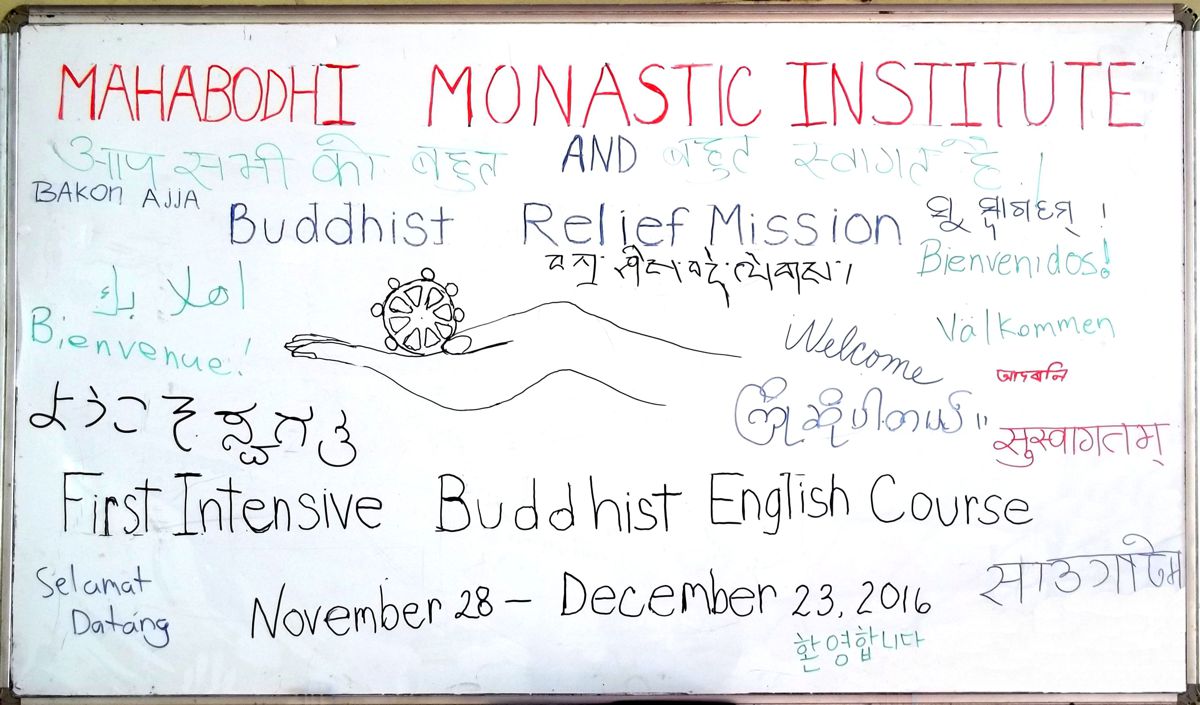 |
|||
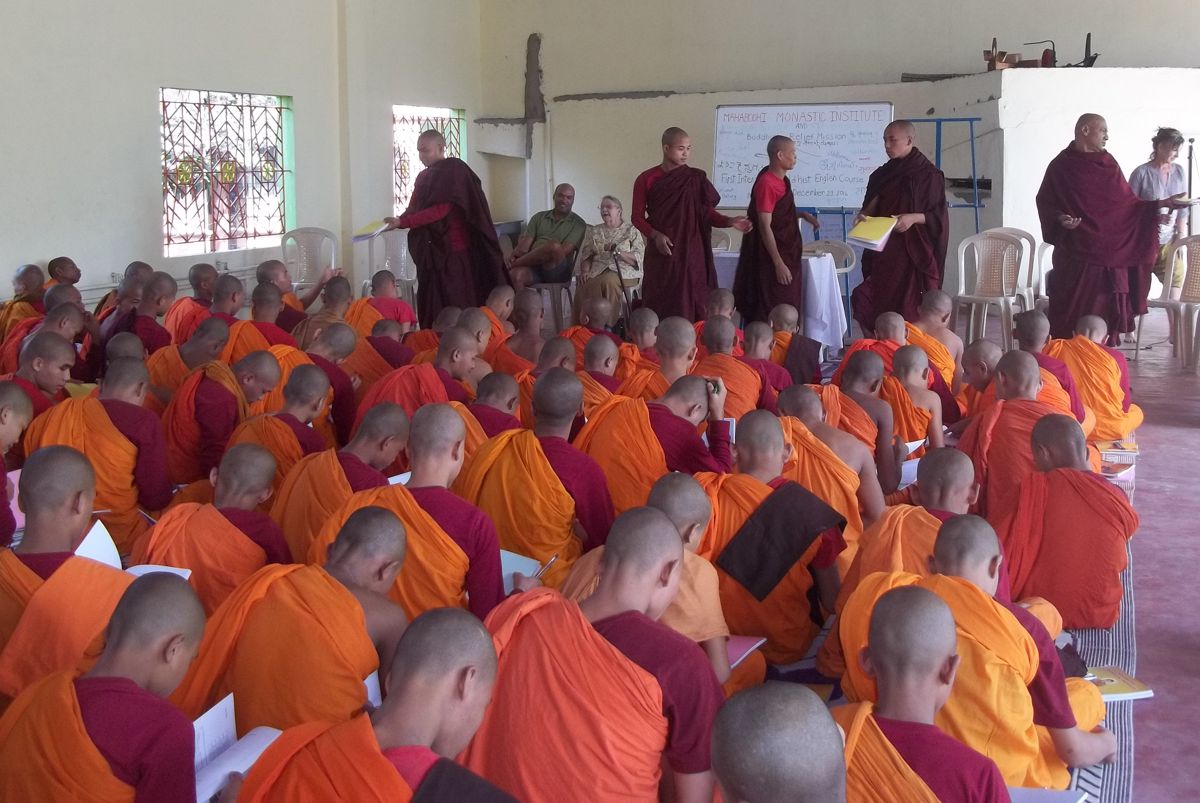 |
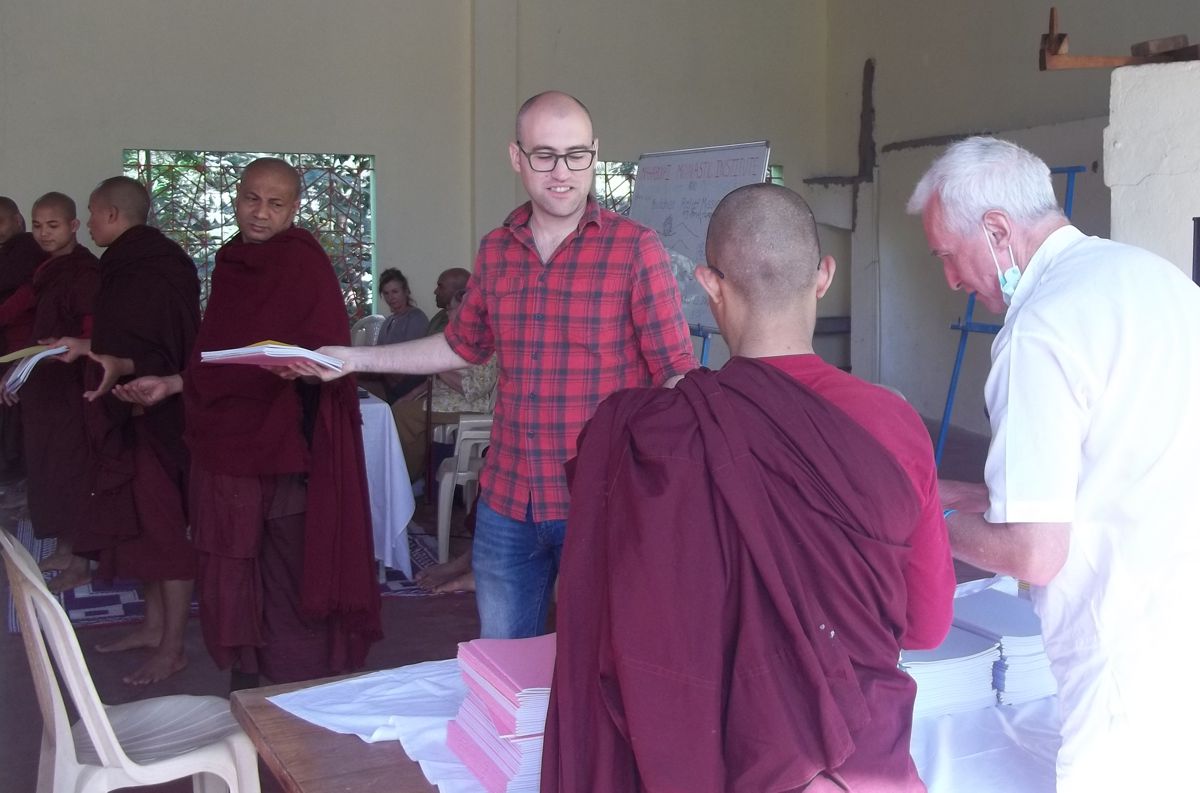 |
||
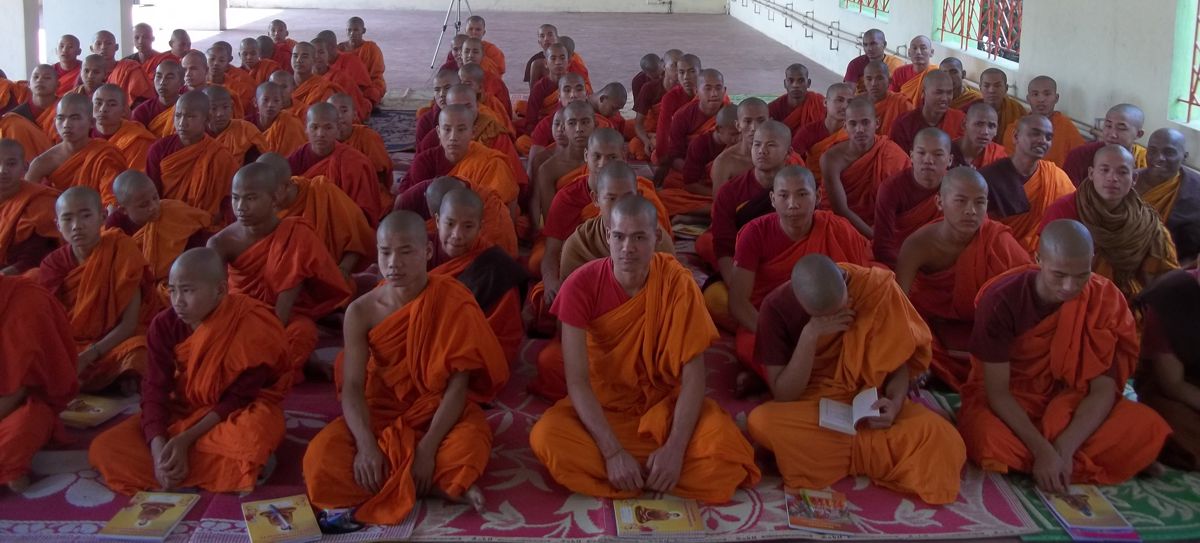 There were 113 students, monks and novices living and studying at the monastery. Most of them were from the Northeast--Assam, Mizoram, Tripura, and Arunachal Pradesh--but some from other parts of India. Altogether, there were about fifteen ethnic groups and languages represented. Some of them did not even speak Hindi fluently, so the lingua franca had to be English.
There were 113 students, monks and novices living and studying at the monastery. Most of them were from the Northeast--Assam, Mizoram, Tripura, and Arunachal Pradesh--but some from other parts of India. Altogether, there were about fifteen ethnic groups and languages represented. Some of them did not even speak Hindi fluently, so the lingua franca had to be English.
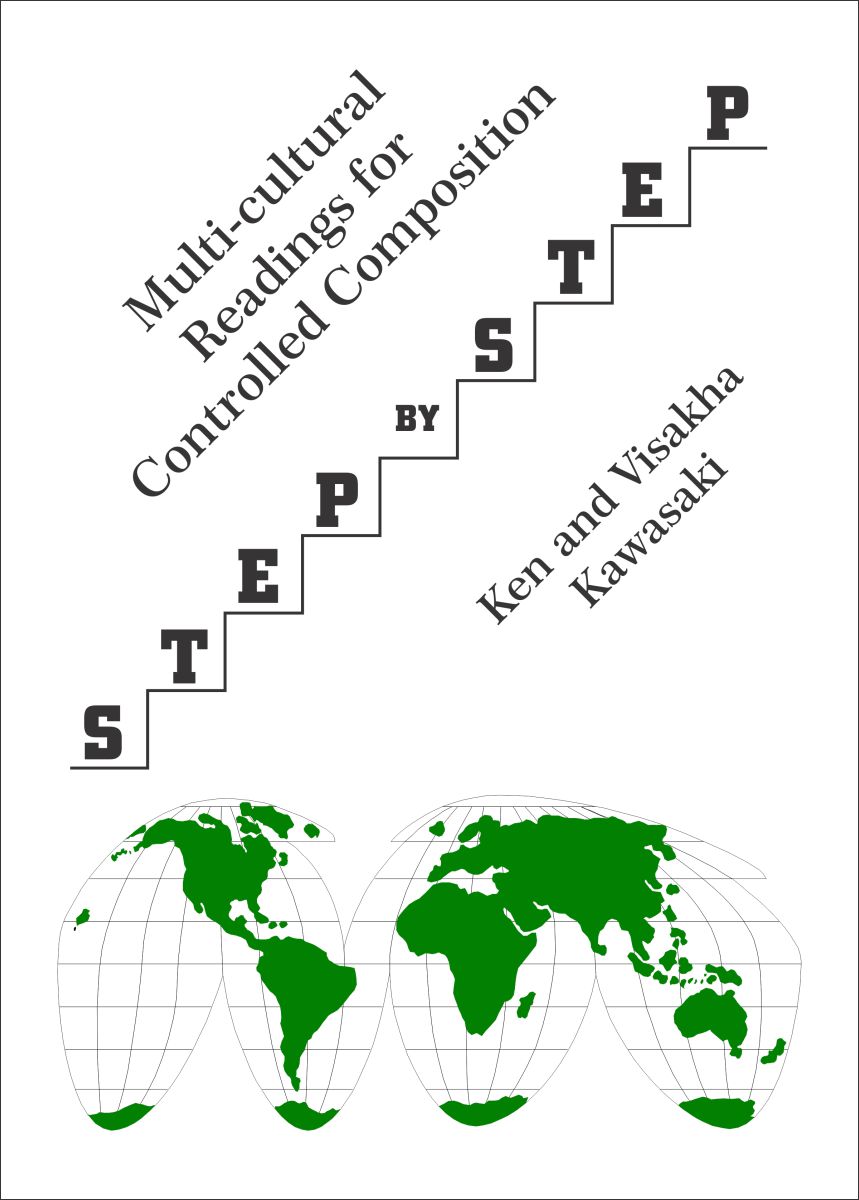 The students threw themselves into the writing lessons, some completing three or four passages every day. We discovered, however, that few of them had had much exposure to grammar. The point of controlled composition is to provide practice with subject and verb agreement, gender, singular and plural, and tenses--concepts a student has "learned" but not "mastered." Thus, some of the exercises were particularly challenging for some students, but no one seemed to get discouraged. Three times a day the drop-off boxes were filled with notebooks, and all the students were eager to get them back and try again. We enjoyed correcting Step by Step exercises much more than we did the old 10 Steps, which we'd used for about ten years, because these new passages are more interesting and relevant to students outside the United States.
The students threw themselves into the writing lessons, some completing three or four passages every day. We discovered, however, that few of them had had much exposure to grammar. The point of controlled composition is to provide practice with subject and verb agreement, gender, singular and plural, and tenses--concepts a student has "learned" but not "mastered." Thus, some of the exercises were particularly challenging for some students, but no one seemed to get discouraged. Three times a day the drop-off boxes were filled with notebooks, and all the students were eager to get them back and try again. We enjoyed correcting Step by Step exercises much more than we did the old 10 Steps, which we'd used for about ten years, because these new passages are more interesting and relevant to students outside the United States.
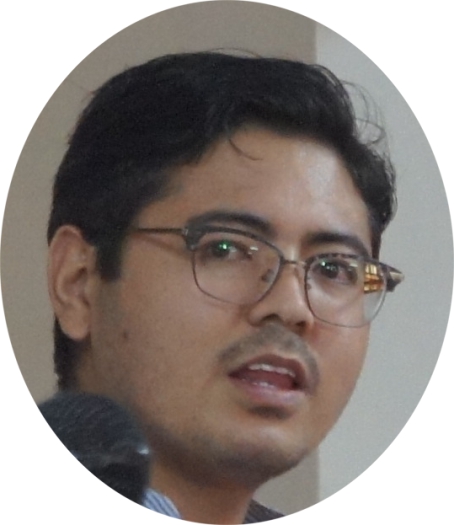 |
|
|
Vajira
|
|
 |
|
|
Navo
|
|
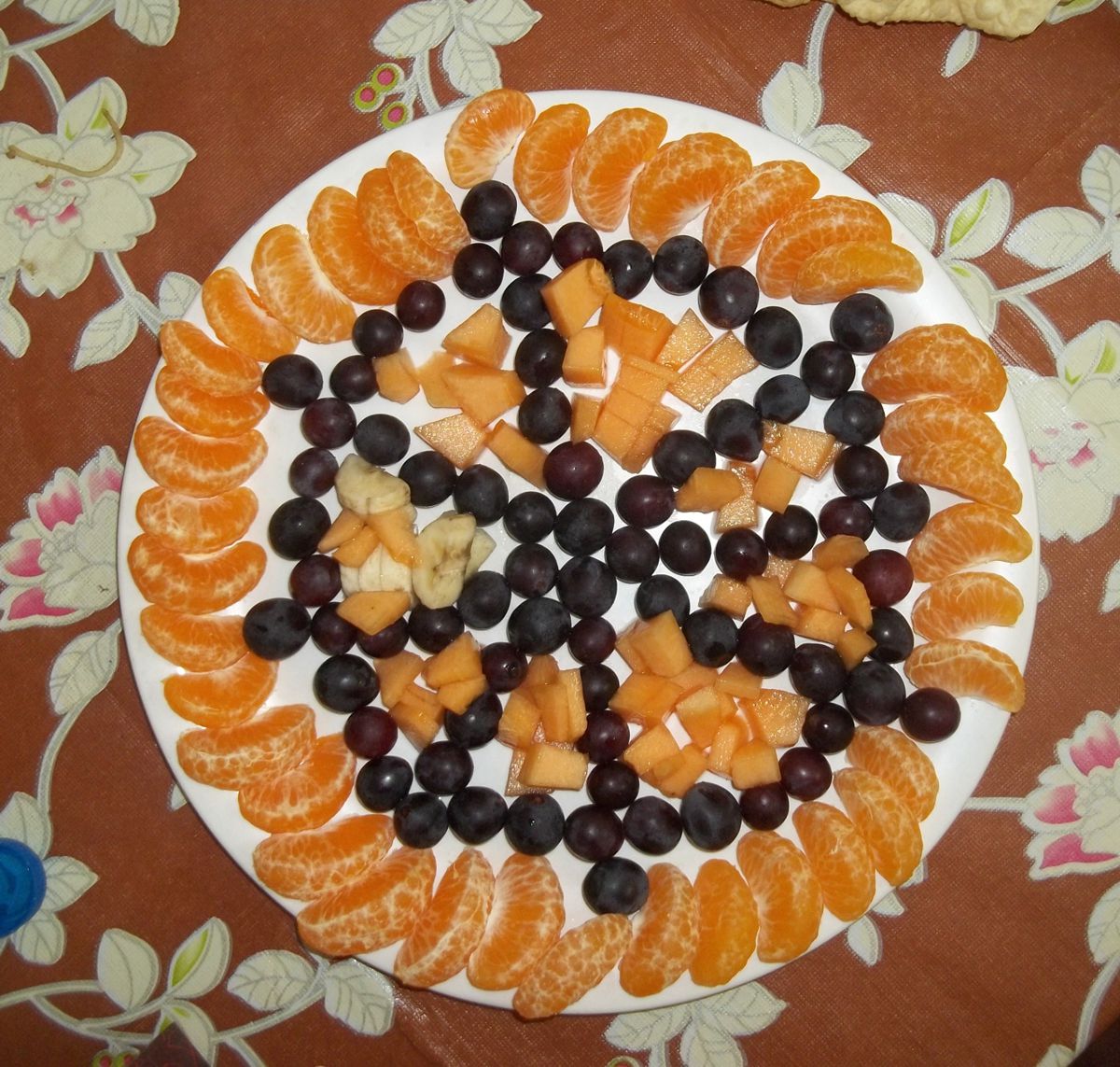 |
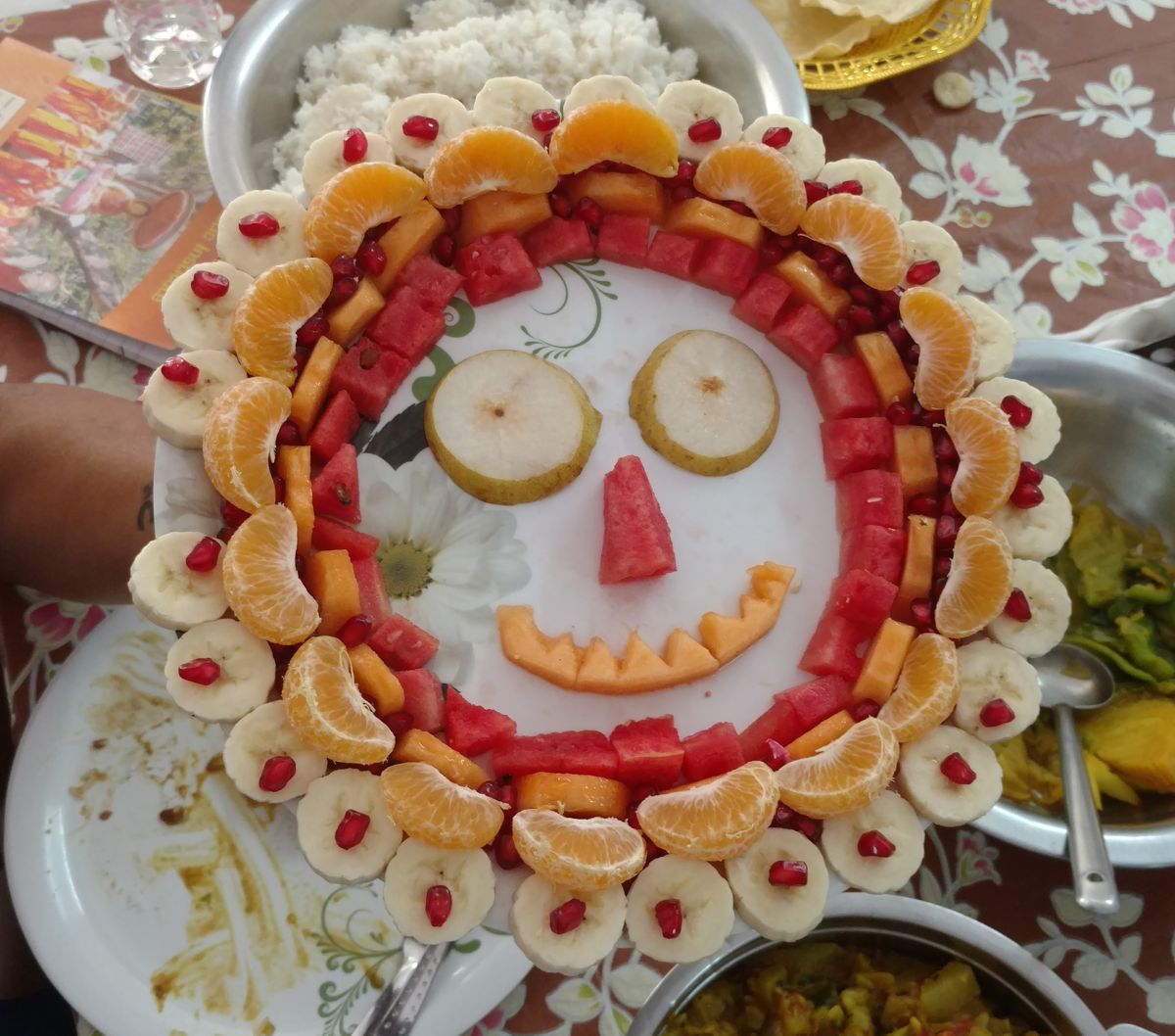 |
|||
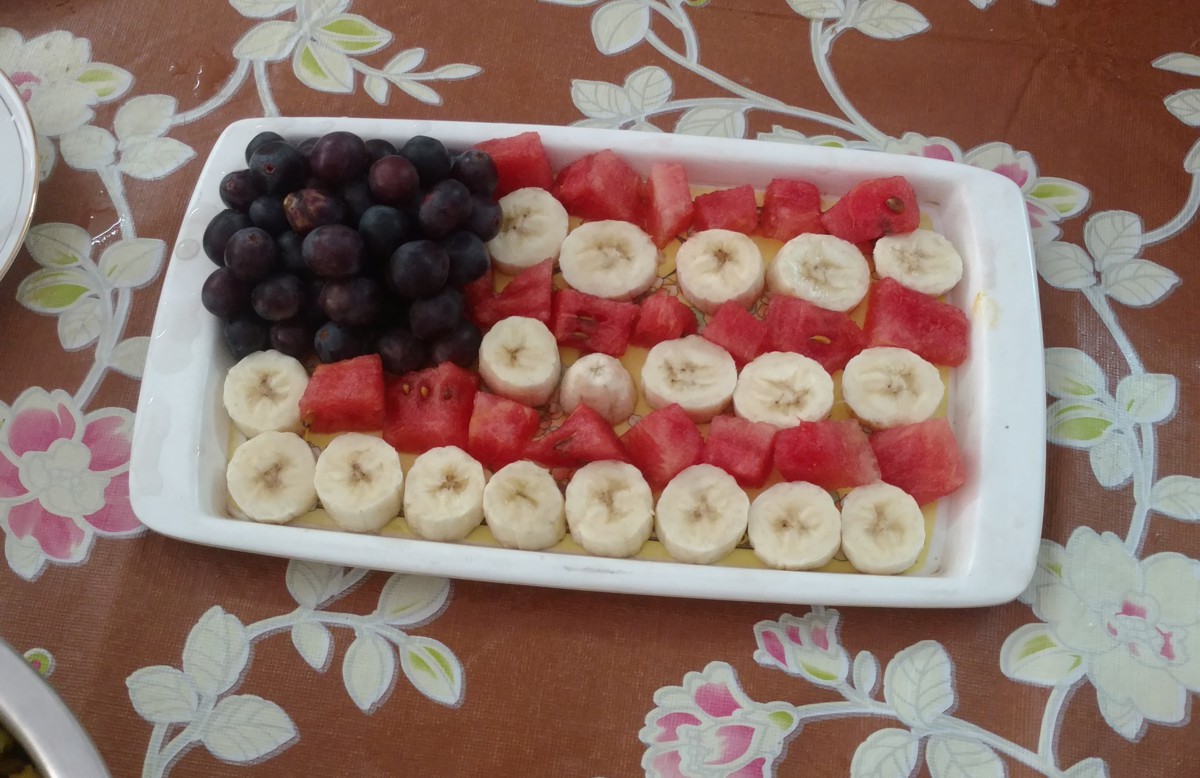 |
||||
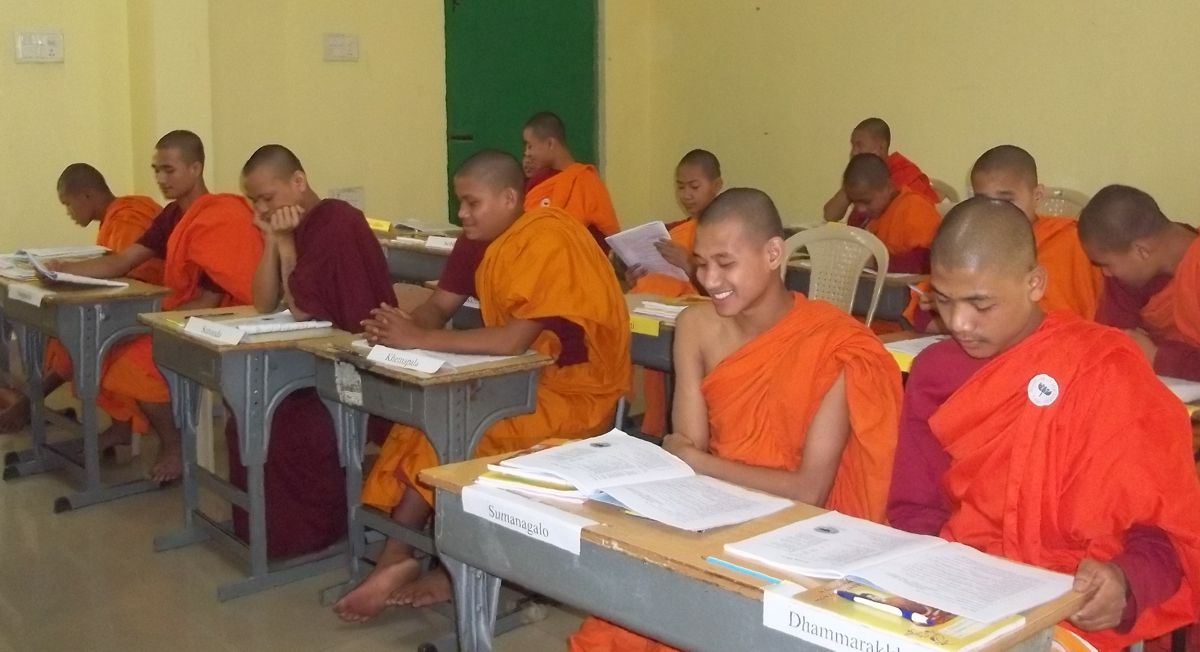 |
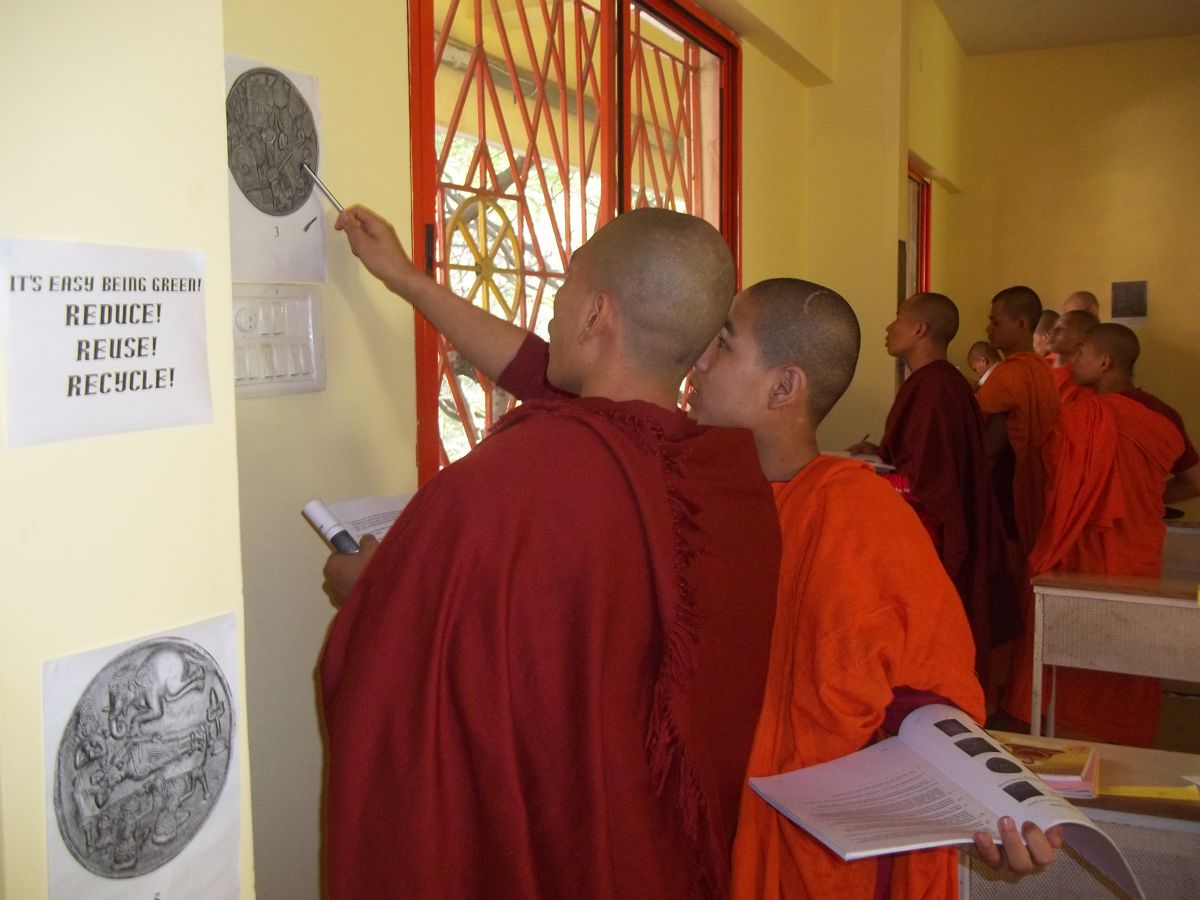 |
|
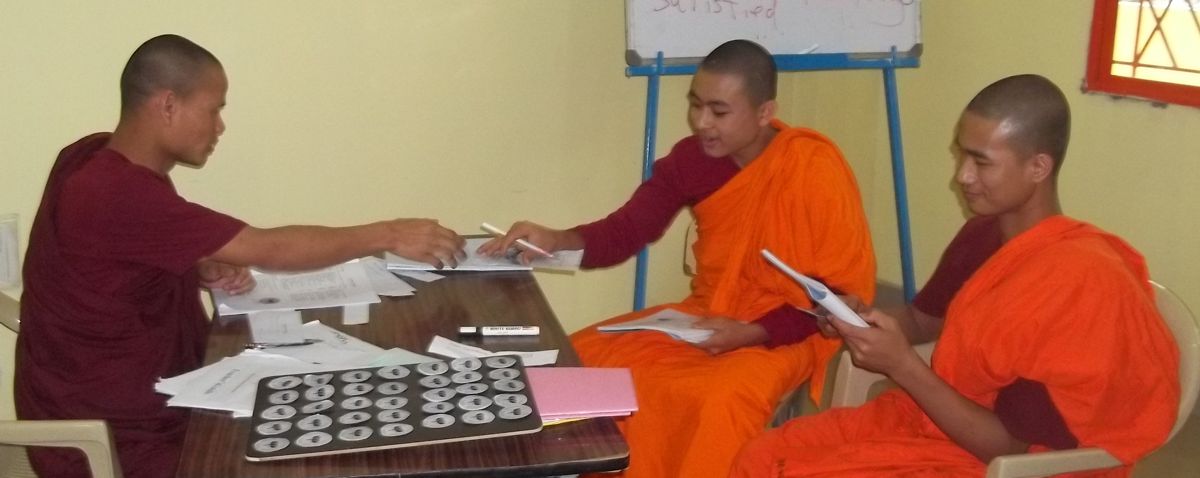 |
||
In one lesson, one of the pilgrims, Marie, receives a phone call from her father in France, announcing that her nephew, Pierre, has been killed in a traffic accident. The lesson centers on how to express sympathy appropriately, followed by several death meditations We were touched when, after having acted out the dialog for their peers, one student asked, "Is this true?" We took that as a real compliment!
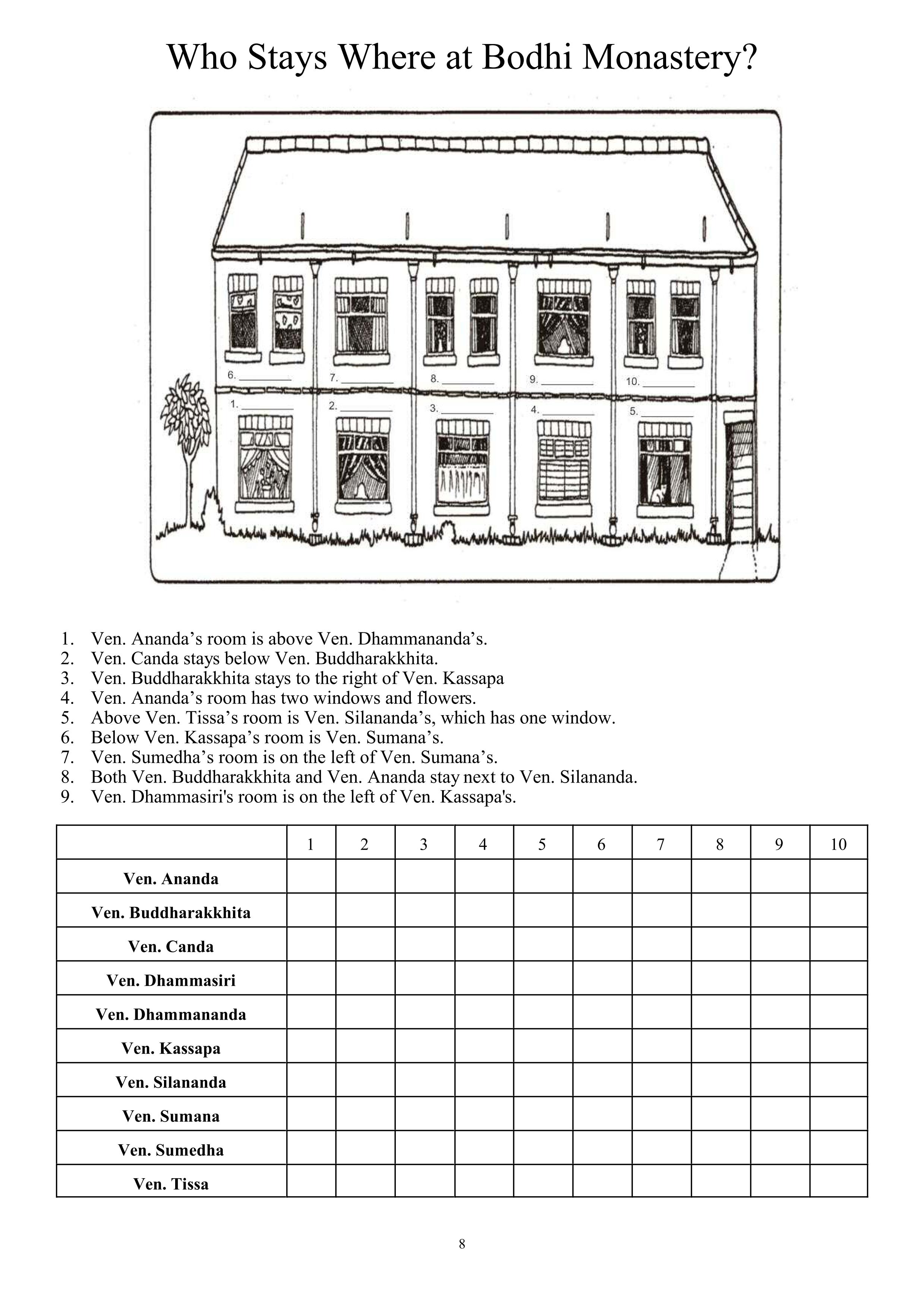 Both teachers and students enjoyed the variety of exercises in the activity book. They were having so much fun that, in some cases, they completed two or three in one class period. They seemed empowered by solving the logic puzzles. Of course, they had to read them in English to understand what was needed, but they realized that the exercise depended much more on orderly thinking and deduction than on language skill. Once they grasped the process, they were keen to try more on their own. In critical-thinking exercises, we always reiterated that, if they could justify it, any answer was acceptable. We were amused one day in working on "Odd Man Out." The four items (from the 32 parts of the body) were: bile, blood, excrement, and sweat. The students were puzzled. Which one which was different from the others and why? When we explained that the category was "fluids or liquids," one of the students piped up, "Sometimes excrement is liquid!" That is true, isn't it?
Both teachers and students enjoyed the variety of exercises in the activity book. They were having so much fun that, in some cases, they completed two or three in one class period. They seemed empowered by solving the logic puzzles. Of course, they had to read them in English to understand what was needed, but they realized that the exercise depended much more on orderly thinking and deduction than on language skill. Once they grasped the process, they were keen to try more on their own. In critical-thinking exercises, we always reiterated that, if they could justify it, any answer was acceptable. We were amused one day in working on "Odd Man Out." The four items (from the 32 parts of the body) were: bile, blood, excrement, and sweat. The students were puzzled. Which one which was different from the others and why? When we explained that the category was "fluids or liquids," one of the students piped up, "Sometimes excrement is liquid!" That is true, isn't it?
 |
|
| Click the photo to see more photos of fun activities. | |
In one of his Sunday Dhamma lessons, Ven. Ananda explained that one of the eight conditions for wisdom was "asking questions." The next day in class, we recalled this to the students and encouraged them to ask questions whenever they did not understand anything in the lesson. This seemed to dispel much of the shyness they had previously demonstrated, and they began asking not only about vocabulary items, but about the content of some of the lessons. For example, as we were reviewing the sites around BuddhaGaya, some to them asked what happened to the stupas we were referring to. We realized that they had not learned about the disappearance of Buddhism from India, and this led to an interesting discussion.
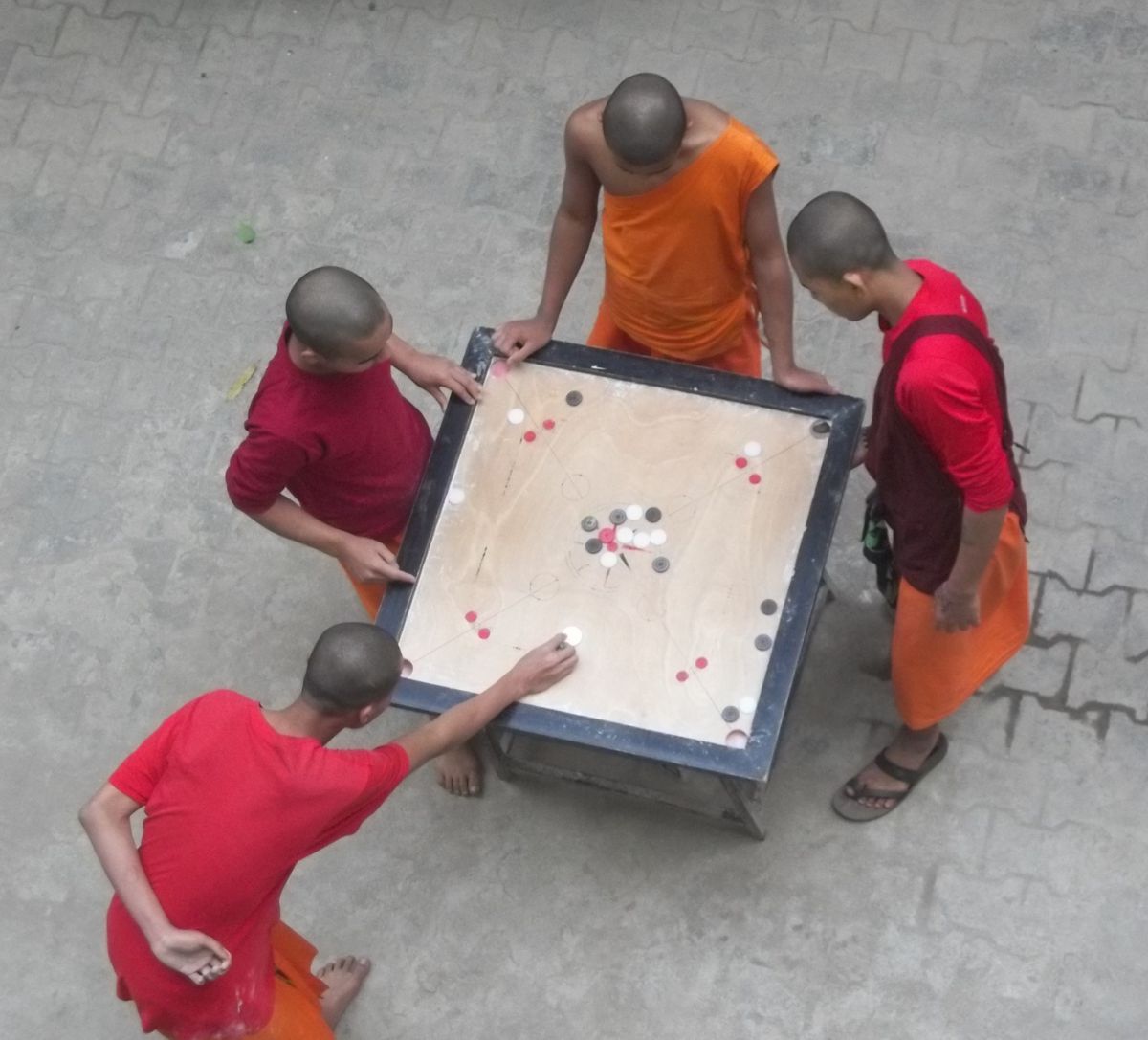 Every morning before classes began, a crew of novices cleaned all the floors of our guest house. They were thorough and efficient. From the balcony, we could see other novices then and between classes, fulfilling their duties of keeping the monastery clean and running smoothly. Whenever Ken went up to the washing machine, he passed novices arranging flowers to adorn the altars in the shrine rooms and under the bodhi tree. We never saw anyone loitering. They moved about mindfully. They were quiet, polite, and full of smiles whenever we met. They did have a regular slot of free time every afternoon, however, and many of them used it to play carrom--with gusto!
Every morning before classes began, a crew of novices cleaned all the floors of our guest house. They were thorough and efficient. From the balcony, we could see other novices then and between classes, fulfilling their duties of keeping the monastery clean and running smoothly. Whenever Ken went up to the washing machine, he passed novices arranging flowers to adorn the altars in the shrine rooms and under the bodhi tree. We never saw anyone loitering. They moved about mindfully. They were quiet, polite, and full of smiles whenever we met. They did have a regular slot of free time every afternoon, however, and many of them used it to play carrom--with gusto!
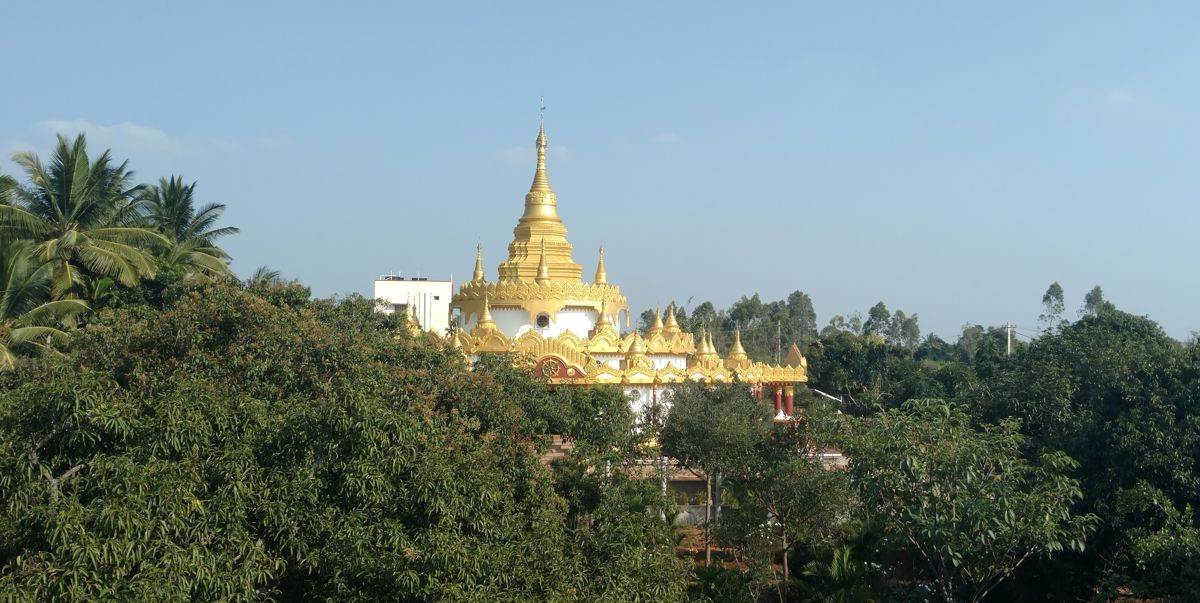 |
|
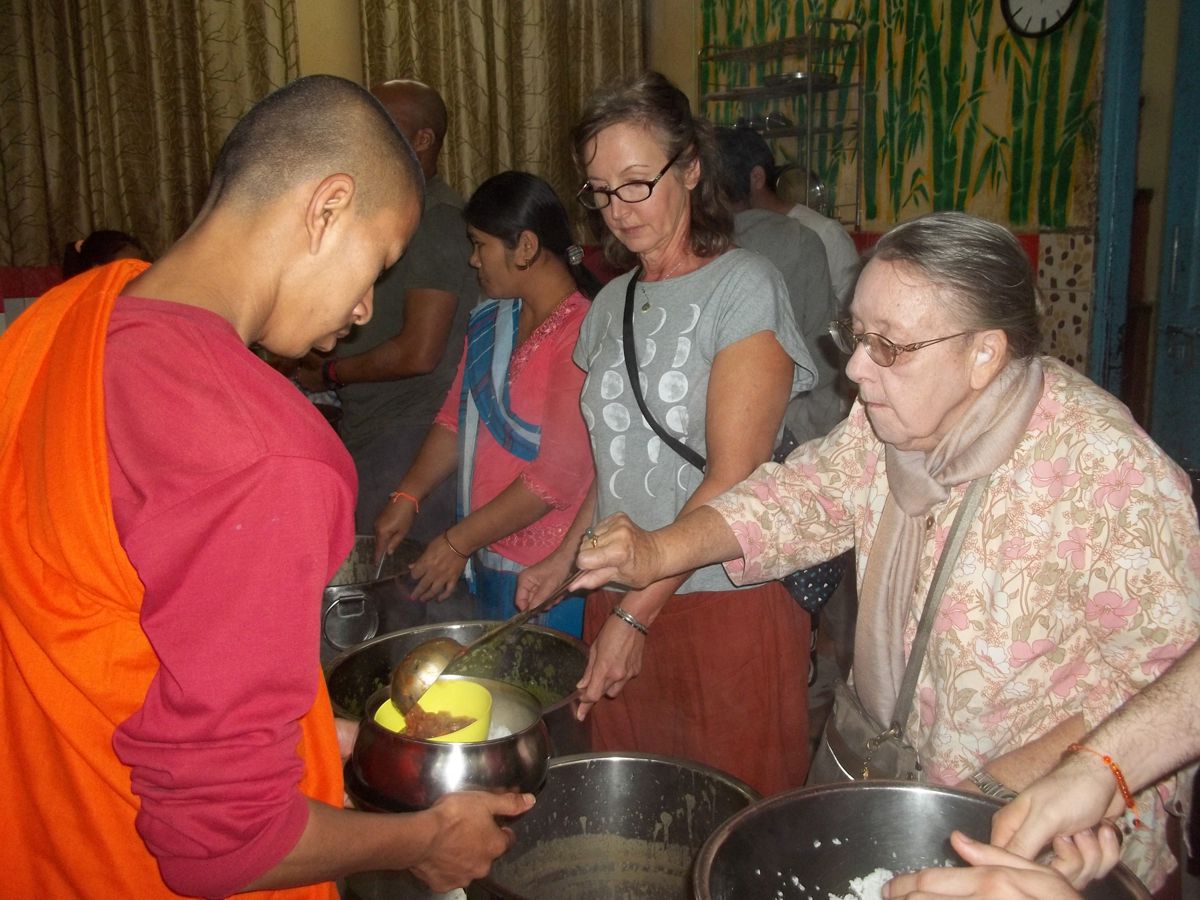 |
|
| Click the photo to see more photos of dana. | |
Many people bemoaned the state of the world as 2016 drew to a close. We were fortunate to be surrounded by good people, engaged in good pursuits and wholesome activities. Still, we had the unsettling feeling of waiting for the other shoe to drop. The news was mean, nasty, and generally unrelentingly negative. There are those who still believe that they won't be hurt by Trumplethinskin's regime. When the man and his advisors deny the reality of climate change and he himself has his little index finger poised over the button and declares that nuclear weapons are useless if not used, we see the Sixth Mass Extinction, either with a bang or a whimper. From that NO ONE is immune.
|
Will Humans Survive the Sixth Great Extinction? |
The debate is over: Earth's sixth great extinction has arrived |
Mother used to say, "One robin does not a spring make!" but the environment is so confused that abnormal is the new normal. Even if the robins survive, "spring" may no longer have any meaning. Here in Sri Lanka, spring flowers bloomed in November, and the market has heaps of succulent mangos, three months early!
Our natural inclination is to be optimistic, wanting to believe that it really can't be that bad, that recycling and conserving energy can save us. With decisions being made by the blind powers that be, we need to be awake to face the coming doom. That doesn't mean, however, that we shouldn't do all we can to forestall it. After all, those are the right things to do! Reduce. Reuse. Recycle. Live simply and wake up!
We know that all is impermanent, so as those mountains--old age, sickness, death, pollution, the extinction of species, desertification, acidification of the oceans and hypoxic zones, drought, floods, polar vortexes, and the rising sea level, not to mention war--are closing in, what should we do but avoid evil, do good and purify our minds. Of course, the extinction of humanity does not mean the end of the Earth. Nature is stronger and more resilient than Man. She will go on without us. We are but one more animal in a cycle that included the dinosaurs. The biggest difference between us and them is that we can greatly influence--but not control--our environment. Nor does the end of life on Earth mean the end of Samsara.
|
A time will come when the ocean will dry up and be no more, but there will be no end of suffering for those who roam and wander, hindered by ignorance and fettered by craving. A time will come when Mount Meru will burn up and be no more, but there will be no end of suffering for those who roam and wander, hindered by ignorance and fettered by craving. A time will come when the earth will be devoured by fire and be no more, but there will be no end of suffering for those who roam and wander, hindered by ignorance and fettered by craving. --Samyutta Nikaya, 22, 99 |
|||
 About mid-way through the course, Ven. Pannasila came all the way across India to spend a few days with us in Bangalore before taking the train up to Gujarat for a wedding. As Ven. Nandobatha has often remarked, Indian monks work harder than others, traveling great distances for weddings, conversion ceremonies, house blessings, and Dhamma camps, going by train all over the country. It was particularly happy to meet him again in Bangalore, since that is where we first made his acquaintance, back in 2001,on the occasion of Ven. Acharya Buddharakkhita's 80th birthday celebration. Over the years, Ven. Pannasila has become one of our most beloved teachers. He accompanied us on the entire pilgrimage with Bruce, and he joined two intensive courses at Bodhisukha. It was from him that we first became aware of Dalits in India and the importance of Dr. Ambedkar, author of the Indian Constitution. In 2006 we spent several weeks traveling around Maharashtra with him. During that tour we visited many historical places, met many Buddhist families and learned much.
About mid-way through the course, Ven. Pannasila came all the way across India to spend a few days with us in Bangalore before taking the train up to Gujarat for a wedding. As Ven. Nandobatha has often remarked, Indian monks work harder than others, traveling great distances for weddings, conversion ceremonies, house blessings, and Dhamma camps, going by train all over the country. It was particularly happy to meet him again in Bangalore, since that is where we first made his acquaintance, back in 2001,on the occasion of Ven. Acharya Buddharakkhita's 80th birthday celebration. Over the years, Ven. Pannasila has become one of our most beloved teachers. He accompanied us on the entire pilgrimage with Bruce, and he joined two intensive courses at Bodhisukha. It was from him that we first became aware of Dalits in India and the importance of Dr. Ambedkar, author of the Indian Constitution. In 2006 we spent several weeks traveling around Maharashtra with him. During that tour we visited many historical places, met many Buddhist families and learned much.
 On Sunday afternoon, Ven. Pannasila took us across town to the Dr. Ambedkar center to meet Ven. Vinayarakkhita, whom we had met ten years ago at a Vihara in Hyderabad. In the meantime, that monastery has become part of the Mahabodhi Society, and Ven. Vinayarakkhita served for several years as headmaster of the school in Bangalore. Now he is residing at the center in Bangalore, in the most beautiful kuti we have ever seen. The entire complex is wonderfully landscaped. On both sides of the lane from the kuti to the community hall are groves of sandalwood trees which grow wild in Karnataka. (It is against the law to carry a living sandalwood tree out of the state!)
On Sunday afternoon, Ven. Pannasila took us across town to the Dr. Ambedkar center to meet Ven. Vinayarakkhita, whom we had met ten years ago at a Vihara in Hyderabad. In the meantime, that monastery has become part of the Mahabodhi Society, and Ven. Vinayarakkhita served for several years as headmaster of the school in Bangalore. Now he is residing at the center in Bangalore, in the most beautiful kuti we have ever seen. The entire complex is wonderfully landscaped. On both sides of the lane from the kuti to the community hall are groves of sandalwood trees which grow wild in Karnataka. (It is against the law to carry a living sandalwood tree out of the state!)
 |
|
| Click the photo to see all the photos of the Dr. Ambedkar center | |
Our discussion with Ven. Vinayarakkhita revealed that we share a number of ideals--critical thinking, community--based learning, and discovery rather than memorization. He explained that Dalit Buddhists are more interested in practical Buddhism than in the mythology, philosophy, devotion, and dogma, the staples of "traditional Buddhists". He said that he would like to include Buddhist economics, Buddhist ecology, Buddhist ethics, and human rights in the curriculum of the center's school. He asked whether we would be able to provide lessons for these subjects. It's an appealing challenge. Our first thought was to try and simplify Schumacher's classic, Small is Beautiful, for young people. We will send him one of our sets of Coopoly, which might be useful. Unfortunately, this game, though brilliant in its concept, is heavily oriented to American culture. It needs to be revised to include Asian values and concepts. Any volunteers?
Ven. Vinayarakkhita described the Buddhist camp which the center holds in May, during the school vacation. He feels that this would be the perfect venue for introducing these subjects, as well as for an intensive English course. The time-frame is a bit tight for us to be able to provide much for this year's camp, but we'll do our best. We are looking for ideas and suggestions for materials and would be glad to hear from anyone interested in volunteering!
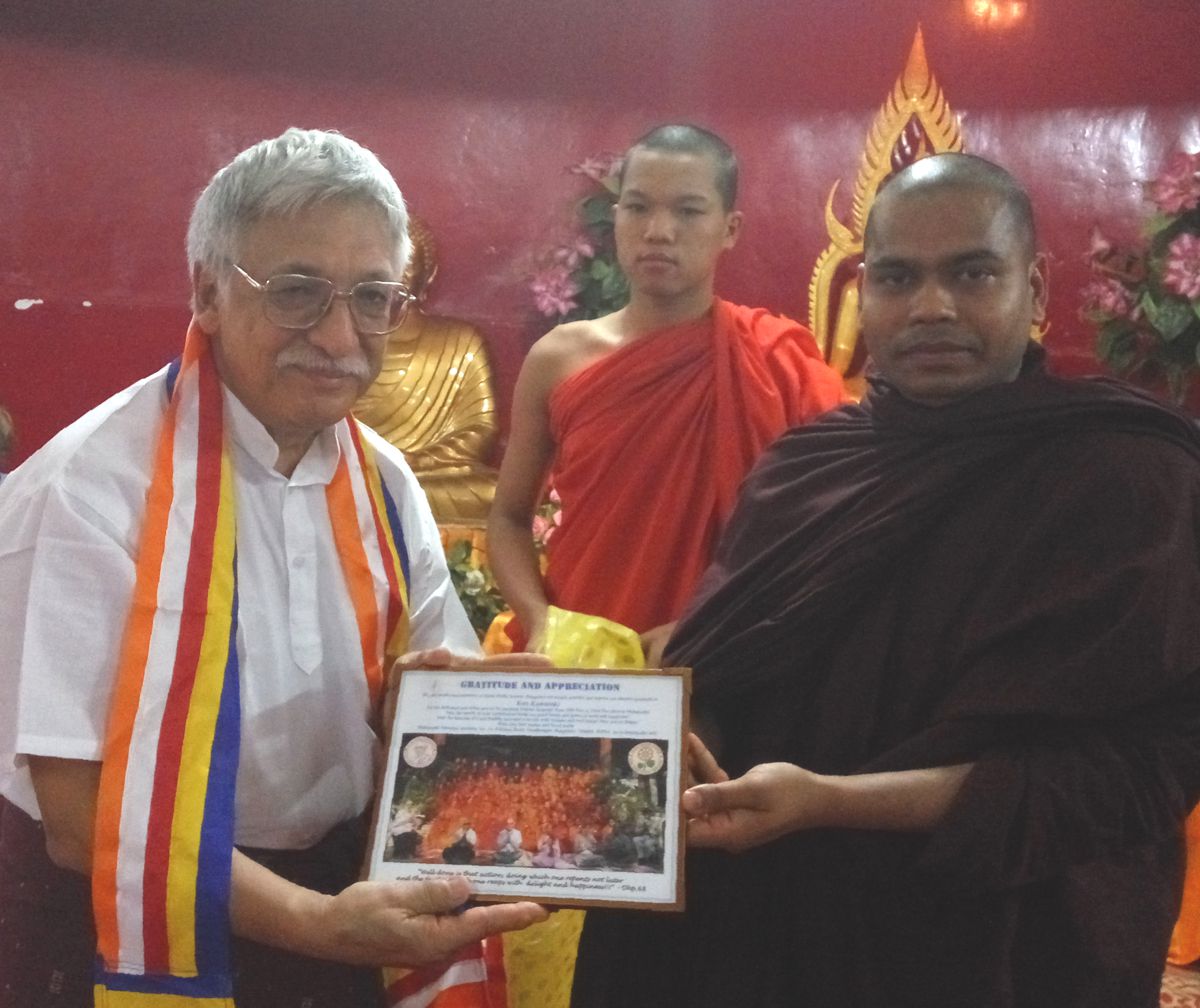 |
|
| Click the photo to see all the photos of the last day | |
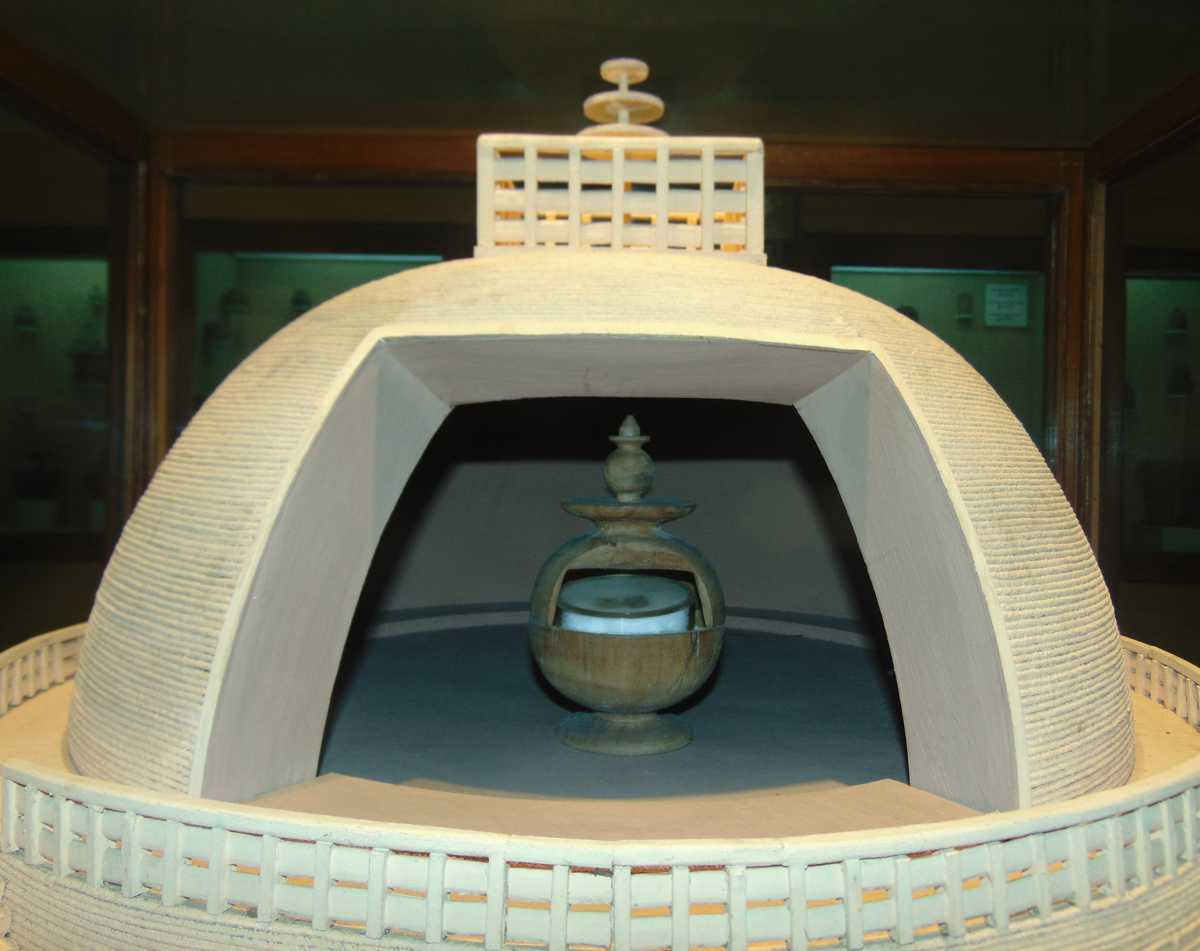 |
|
| Click the photo to see more photos taken at the Indian Museum on our previous visit. | |
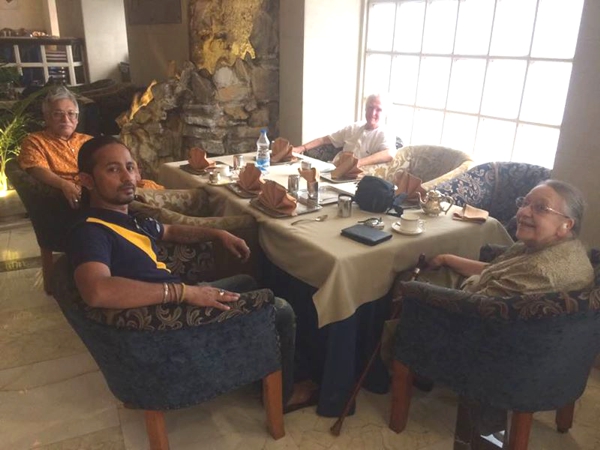 The only quiet place was the room displaying the Buddha's relics from Piprahwa. After a few minutes of reflection there, we retreated quickly to Zaranj, the restaurant right out of the Raj, where Visakha was waiting. The restaurant hadn't even opened yet, but the waiters allowed us to have tea at a comfortable table while they continued setting up around us. Just as luxurious as the dining room were the restrooms, the best we found during our six-weeks in India.
The only quiet place was the room displaying the Buddha's relics from Piprahwa. After a few minutes of reflection there, we retreated quickly to Zaranj, the restaurant right out of the Raj, where Visakha was waiting. The restaurant hadn't even opened yet, but the waiters allowed us to have tea at a comfortable table while they continued setting up around us. Just as luxurious as the dining room were the restrooms, the best we found during our six-weeks in India.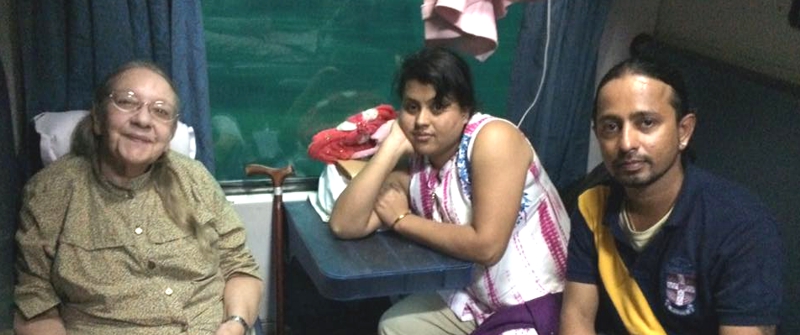 About four o'clock, we met Shilar, Visakha, Sumon, Judith, Steve, and Josh at Sealdah Station to catch the Rajdhani Express for an eight-hour trip to Gaya. Ewen and Ken took top berths, which were comfortable, but only in the prone position. The space was only about 18 inches high. Indian Railway service is better than many airlines. Shortly after departure, you receive a snack, followed by a cup of soup and breadsticks. A little later you get a full meal with rice, curry, a chapati, dessert, and tea. Just as you decide to retire, the steward comes through with ice cream, but you probably pass because you are full and almost asleep. There are six seats in one compartment (no doors), but only one electrical outlet, so you have to flip a coin to decide who gets to charge his phone.
About four o'clock, we met Shilar, Visakha, Sumon, Judith, Steve, and Josh at Sealdah Station to catch the Rajdhani Express for an eight-hour trip to Gaya. Ewen and Ken took top berths, which were comfortable, but only in the prone position. The space was only about 18 inches high. Indian Railway service is better than many airlines. Shortly after departure, you receive a snack, followed by a cup of soup and breadsticks. A little later you get a full meal with rice, curry, a chapati, dessert, and tea. Just as you decide to retire, the steward comes through with ice cream, but you probably pass because you are full and almost asleep. There are six seats in one compartment (no doors), but only one electrical outlet, so you have to flip a coin to decide who gets to charge his phone.
Gaya Station seemed as large and as sprawling as Sealdah, and the walk from the platform to the exit was VERY long. (Thank goodness that, in India, you never have to transport your luggage. Porters are ubiquitous and efficient.) Our mimibus was waiting for us and took us to Mahabodhi Parahita Myanmar Monastery, the pilgrims' resthouse established by Ven. Nandobatha and the Young Buddhist Monks Literacy Mission, where we stayed in February, and where, in 2013, we had held the intensive course. The next morning, at breakfast, we were pleased to see that Jataka Tales of the Buddha and A Pilgrim's Companion had been placed on a table in front of the dining hall for purchase. We've long hoped to see Buddhist books from BPS and BCC (ours included) in bookstores in India, but that just hasn't happened.
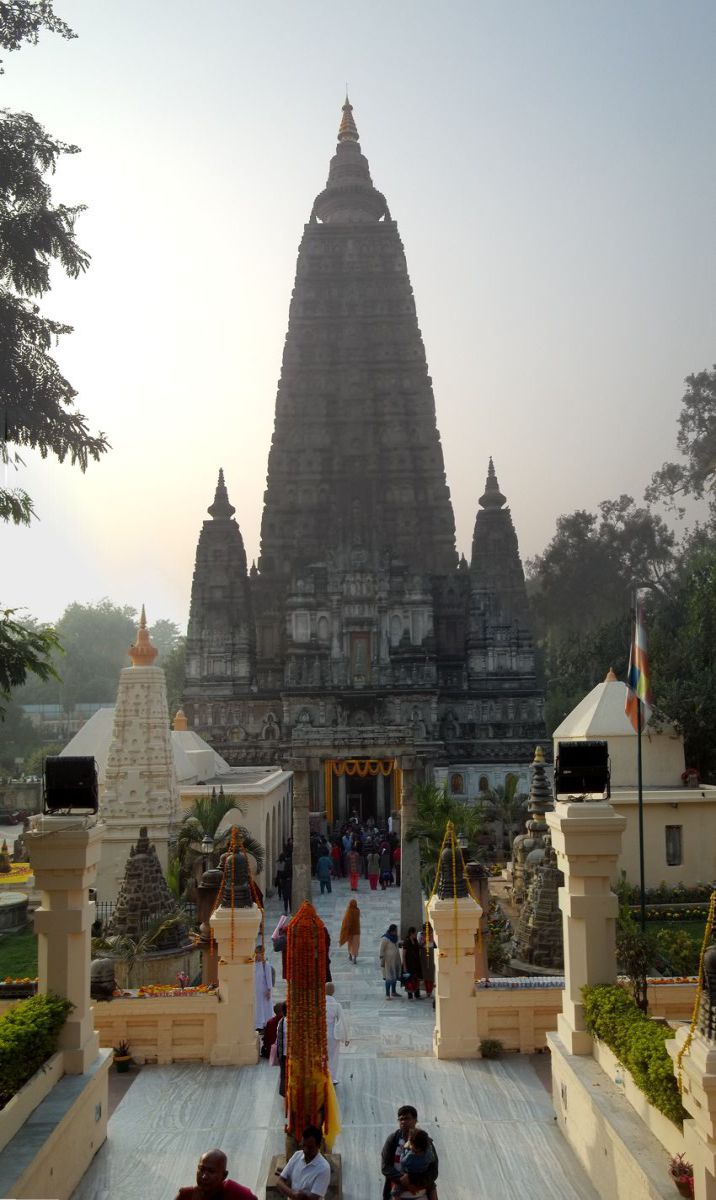 |
|
| Click the photo to see more photos of the MahaBodhi Complex | |
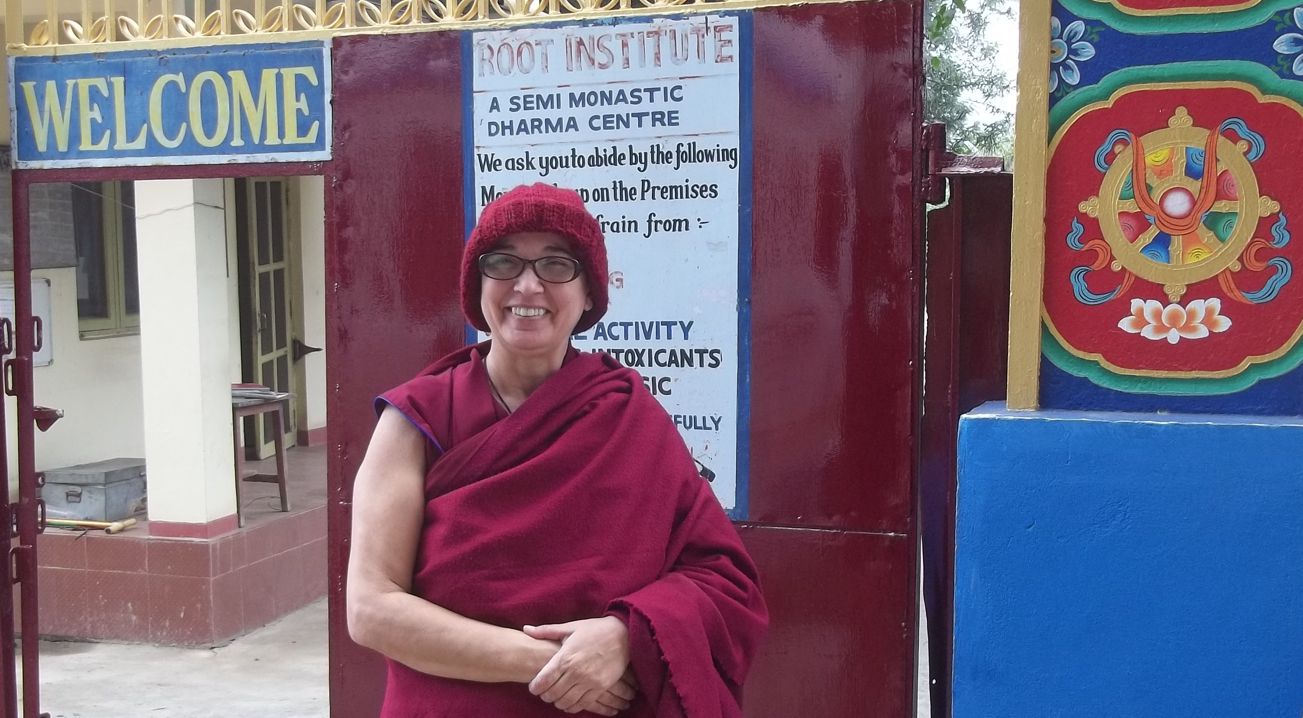 |
|
| Click the photo to see more photos of the day with Ven. Tsundue | |
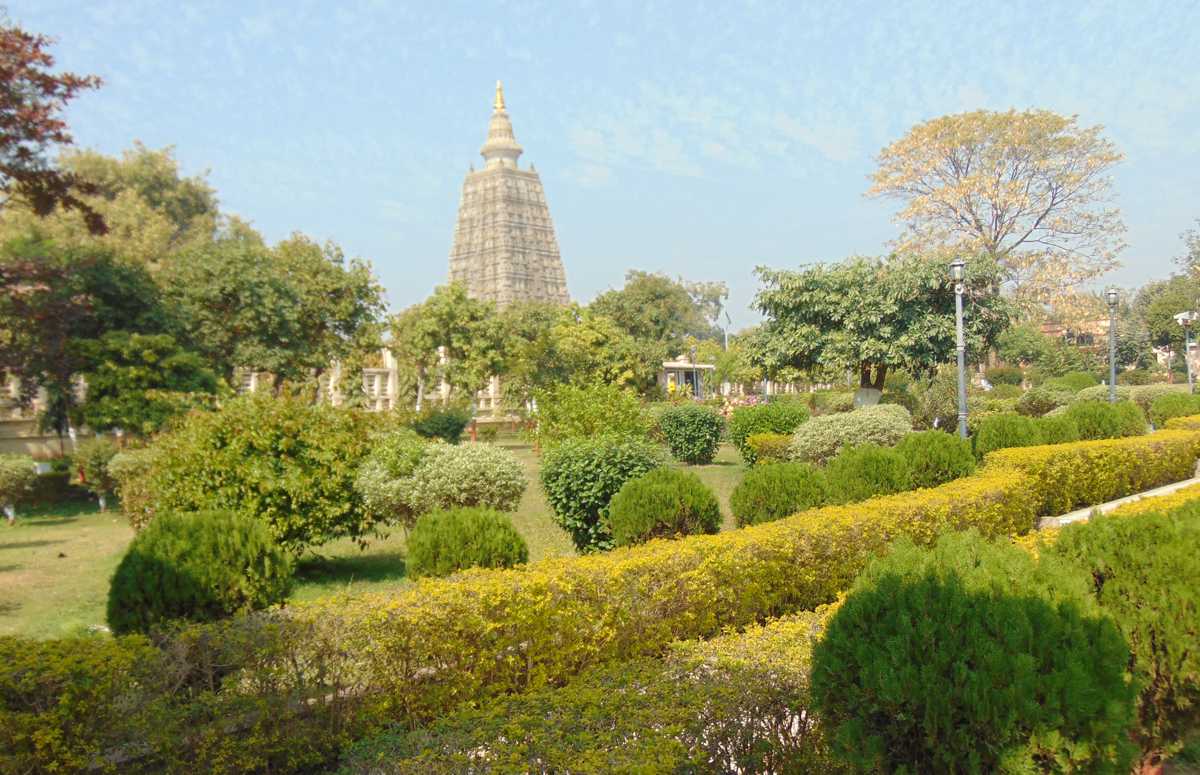
Meeting people in BuddhaGaya was an unexpected pleasure. Almost every time we sat in the dining hall, Rajiv brought someone to our table. The biggest surprise was meeting the Burmese woman that Rajiv had told us about several years ago. She had gone to Chennai for a kidney transplant, but there she was cheated and given no treatment at all. Hearing about Rajiv, she contacted him, and he was able to make all the arrangements at Bodhisukha for her transplant operation at Apollo Hospital. She credits him with saving her life. Returning to India with her husband for a pilgrimage, she was delighted to meet Rajiv again!
We also met quite a few old students from earlier Bodhisukha Intensives, some who have since disrobed. One, whom we remembered well as an excellent student, explained that he'd left the monkhood to care for his ailing mother, found some work, but was hoping for something more substantial. After a few minutes of general talk, Rajiv offered him a position as assistant, responsible for a large area in the north, collecting human hair for wigs. This has become Rajiv's main business and because he is honest and fair, with the women, the local collectors, as well as the Indian and Burmese traders, the business is thriving. We are proud of Rajiv and appreciate that he would drop everything to travel with us on this pilgrimage.
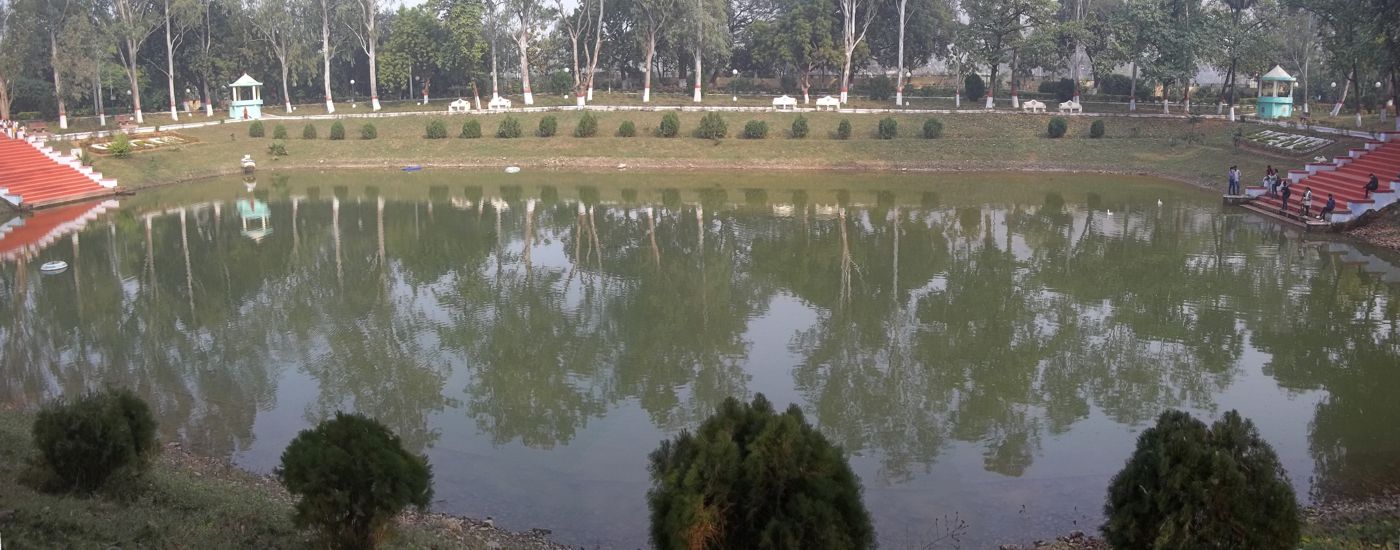 |
|
| Click the photo to see more photos of Rajgir and Nalanda | |
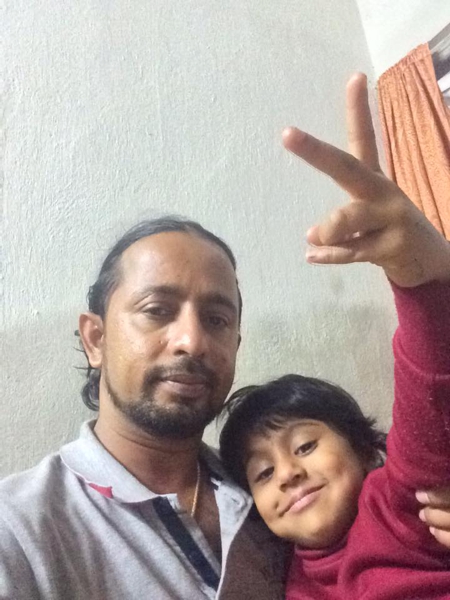 We were scheduled to catch the train from Gaya about four o'clock in the morning and to arrive in Kolkata about ten o'clock New Year's Day. Thus, we could rest at the monastery until about two AM. We were informed that evening, however, that the train was going to be about four hours late, so we could have breakfast at the usual time. When we awoke, we learned that the train was eight to twelve hours late. After only a brief discussion, we asked Rajiv to arrange for the van to take us back to Kolkata. It was a long ride, but we're not sure that the train ever left New Delhi, so we were wise not to have waited. During the entire trip, whenever Visakha (Rajiv's and Shilar's daughter) was awake, she entertained us with her repertory of songs--"I Love the Mountains," "Mary Had a Little Lamb," "In a Cottage, In a Wood," and many more--circulating among her mother, her father, Visakha, Ken, and anyone else who would sing with her. She is smart and delightful! We arrived at Bodhisukha about midnight--exhausted, but glad to be back and out of a vehicle.
We were scheduled to catch the train from Gaya about four o'clock in the morning and to arrive in Kolkata about ten o'clock New Year's Day. Thus, we could rest at the monastery until about two AM. We were informed that evening, however, that the train was going to be about four hours late, so we could have breakfast at the usual time. When we awoke, we learned that the train was eight to twelve hours late. After only a brief discussion, we asked Rajiv to arrange for the van to take us back to Kolkata. It was a long ride, but we're not sure that the train ever left New Delhi, so we were wise not to have waited. During the entire trip, whenever Visakha (Rajiv's and Shilar's daughter) was awake, she entertained us with her repertory of songs--"I Love the Mountains," "Mary Had a Little Lamb," "In a Cottage, In a Wood," and many more--circulating among her mother, her father, Visakha, Ken, and anyone else who would sing with her. She is smart and delightful! We arrived at Bodhisukha about midnight--exhausted, but glad to be back and out of a vehicle.
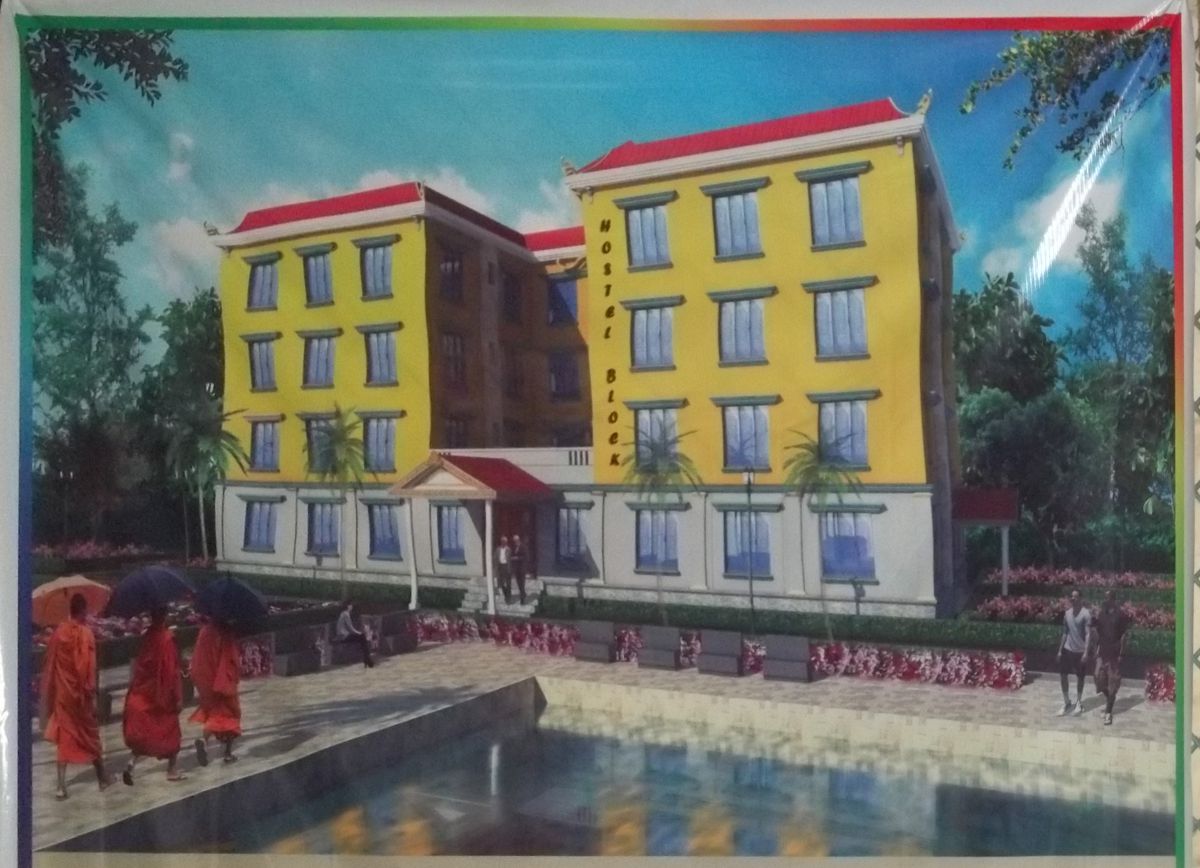 Bodhisukha is changing, and there is a lot of construction going on. About the middle of last year, the school was granted accreditation (referred to in India as "affiliation") by CBSE (Central Board of Secondary Education). This recognition has made it imperative for the kidney transplant patients to vacate classrooms, so a new building is rising on the corner of the pond. When that is completed, most of the old one-story structures will be demolished, and the compound will take on a new, grand look. On the other side of the pond, near the entrance, is a small coffee shop. There is only a narrow path leading to it now, but you can see that the edge of the pond is being built up, so soon Bodhisukha will have a real sidewalk café. We are sure that our little guesthouse is also destined for the wrecking ball, but we expect that its replacement will be more spacious and comfortable.
Bodhisukha is changing, and there is a lot of construction going on. About the middle of last year, the school was granted accreditation (referred to in India as "affiliation") by CBSE (Central Board of Secondary Education). This recognition has made it imperative for the kidney transplant patients to vacate classrooms, so a new building is rising on the corner of the pond. When that is completed, most of the old one-story structures will be demolished, and the compound will take on a new, grand look. On the other side of the pond, near the entrance, is a small coffee shop. There is only a narrow path leading to it now, but you can see that the edge of the pond is being built up, so soon Bodhisukha will have a real sidewalk café. We are sure that our little guesthouse is also destined for the wrecking ball, but we expect that its replacement will be more spacious and comfortable. The lane leading to the pagoda is now lined with splendiferous marigolds, and the lawn in front of the ordination hall has been raised a few inches and delineated by an attractive, low retaining wall. Unfortunately, vehicles are still being parked right inside the main gate, so it isn't always comfortable to sit on our favorite bamboo platform beside the pond.
The lane leading to the pagoda is now lined with splendiferous marigolds, and the lawn in front of the ordination hall has been raised a few inches and delineated by an attractive, low retaining wall. Unfortunately, vehicles are still being parked right inside the main gate, so it isn't always comfortable to sit on our favorite bamboo platform beside the pond.
We had less time that we had expected at Bodhisukha, but we still were able to spend a little with the boys, now quite grown up! Kyaw Jar Ree introduced us to his mother, who happened to be visiting. He and Kyan Thun are both doing fine.
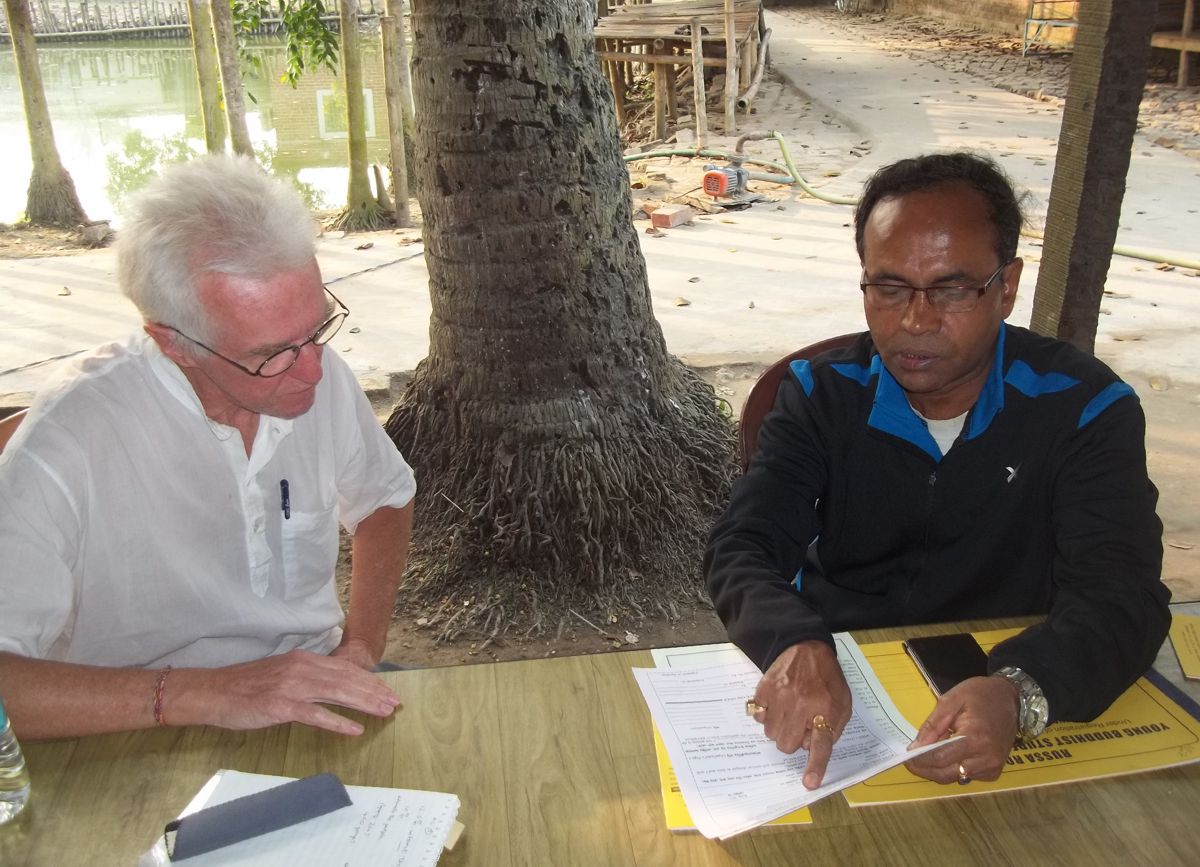
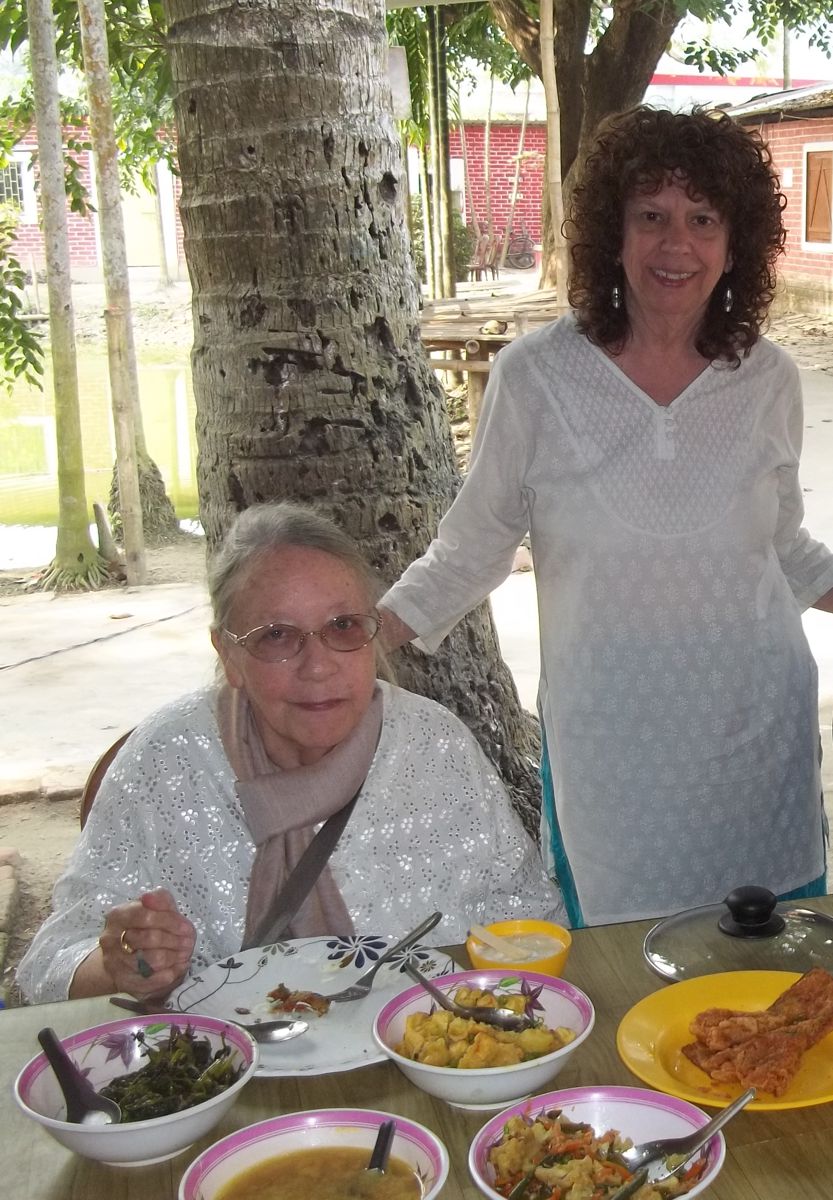 Ven. NandoBatha arranged for Ken, Visakha, Rosalie, and Ewen to meet with Mr. Das, the director of the micro-credit program. He explained every step of the program, and helped us understand how it works for grass-roots community development and improves the status of women in local society. We were deeply impressed by the program's ten-year record. It is built on honesty, commitment, and cooperation. What a contrast to commercial banks and big business! We hope to find something comparable in Sri Lanka. We must find out what Sarvodaya is doing. They have an office in Kandy, so it behooves us to pay them a visit soon.
Ven. NandoBatha arranged for Ken, Visakha, Rosalie, and Ewen to meet with Mr. Das, the director of the micro-credit program. He explained every step of the program, and helped us understand how it works for grass-roots community development and improves the status of women in local society. We were deeply impressed by the program's ten-year record. It is built on honesty, commitment, and cooperation. What a contrast to commercial banks and big business! We hope to find something comparable in Sri Lanka. We must find out what Sarvodaya is doing. They have an office in Kandy, so it behooves us to pay them a visit soon.
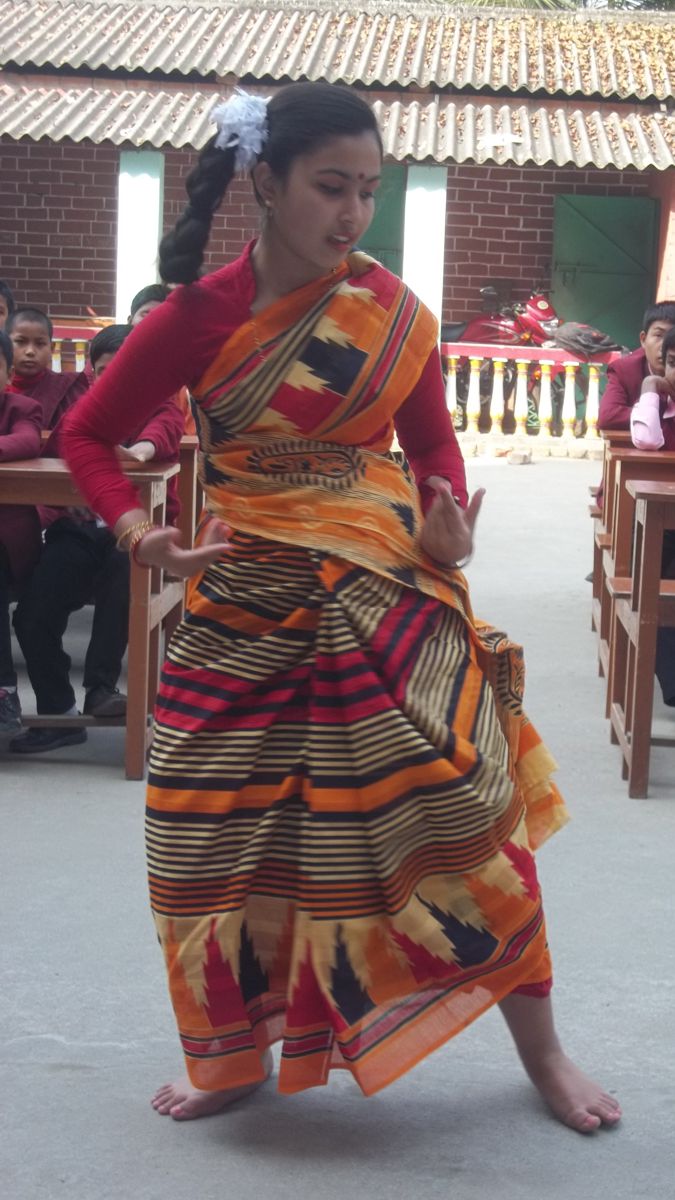 |
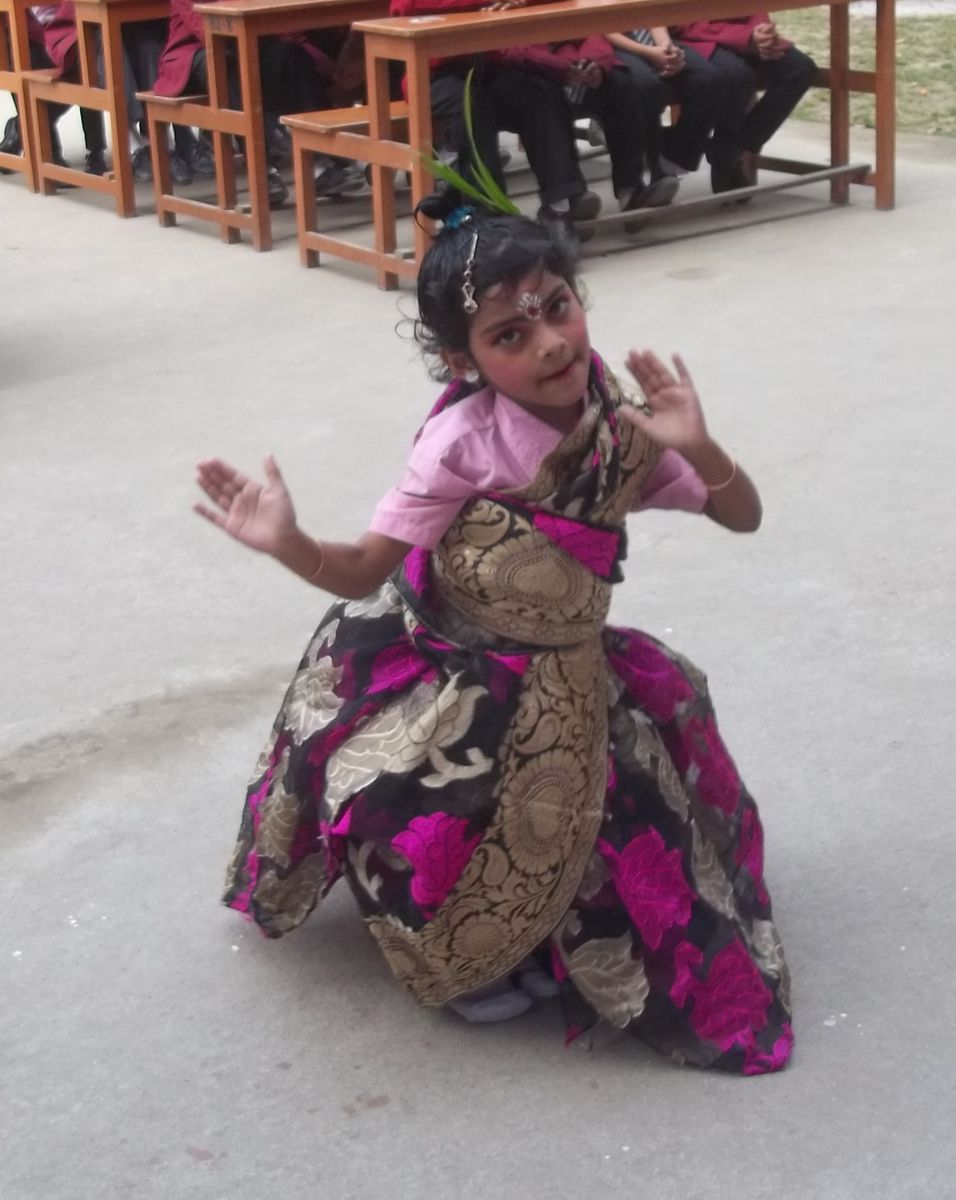 |
|
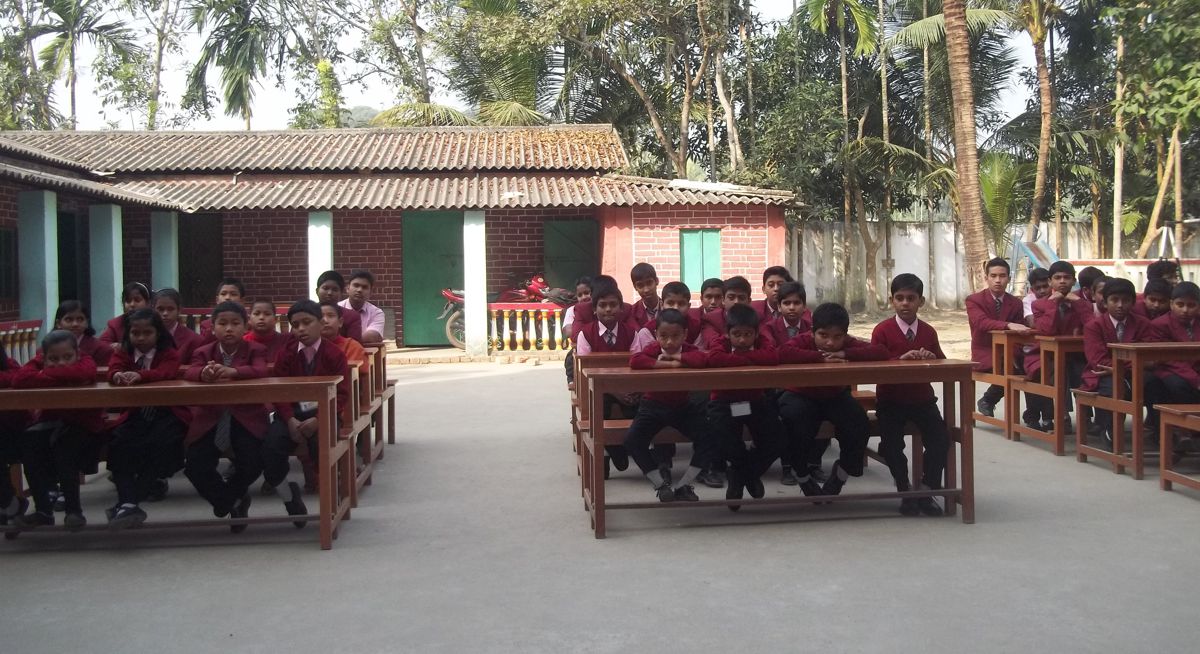 |
||
 |
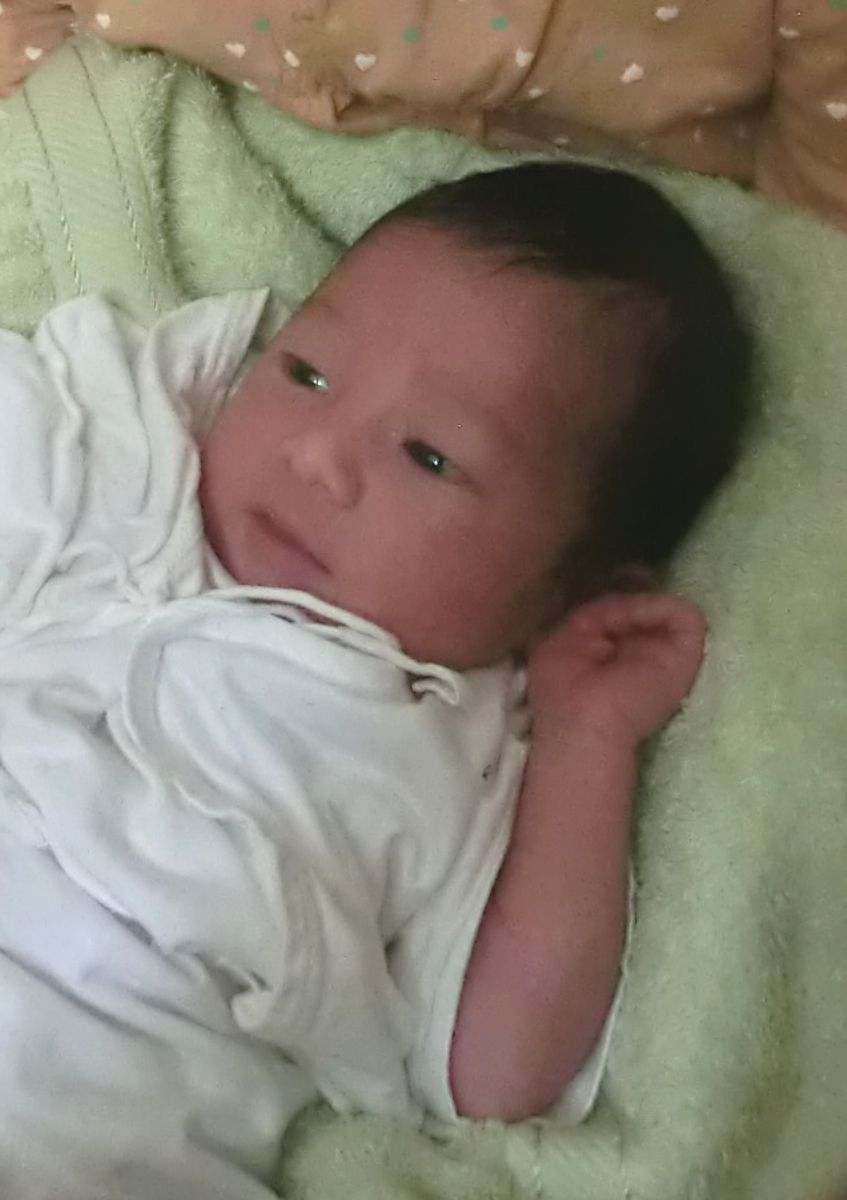 |
|
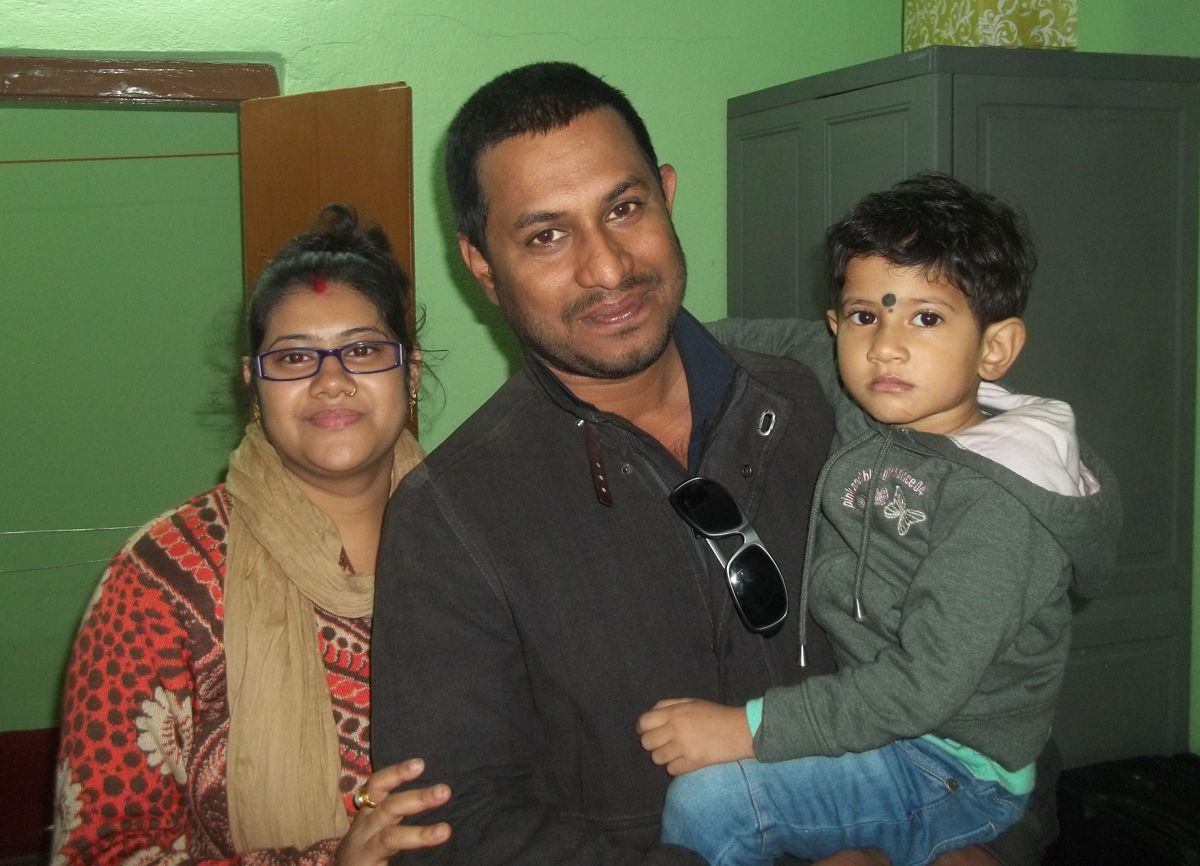 Just before we left for the airport, Abhijit brought his wife, Soma, and their daughter, Samadhi, to meet us. Next year, Soma is going to join Visakha in studying at Bodhisukha. She is a lovely girl. Abhijit is working with an official in one of the political parties of West Bengal. He told us about s the fully-equipped ambulance his party able to get for the local community, filling a great need.
Just before we left for the airport, Abhijit brought his wife, Soma, and their daughter, Samadhi, to meet us. Next year, Soma is going to join Visakha in studying at Bodhisukha. She is a lovely girl. Abhijit is working with an official in one of the political parties of West Bengal. He told us about s the fully-equipped ambulance his party able to get for the local community, filling a great need.As soon as we got back to Sri Lanka, Ken's computer, which had been slowing down for several months, finally gave up. Fortunately, we have had in reserve a desktop (1TB hard disk) we received free a few years ago in a class-action suit against e-Machines. We had been using it for archiving, so there were no programs installed. Ken decided to switch to that computer and to use his laptop (with its 2TB hard disk) for travel. Of course, this meant copying all data and installing necessary software, which took a lot of time. This was not difficult, but it was frustrating because it took time away from this report, for the lateness of which we humbly apologize. Not getting the report out quickly also means that we are not hearing from those of you always respond. For this we are truly sorry, because we are eager to hear news from so many of you. We have been home for more than a month, and we are still writing and editing photos! Oh dear!
A few days ago, Ven. Amilasiri informed us that he was coming to Kandy, and wanted to stop by for a few minutes before going back to Kurunegala. We had not met him since November, so it was we were pleased to be able to offer him tea and a picture of the main image from the great MahaBodhi Temple. We were sorry to learn, however, that the reason for his trip to Kandy was to visit one of the teachers from the pirivena (school for novices). That monk had developed back pain and had come to the hospital. The doctors discovered that it was cancer which has metastasized and is not operable. He will have to come to Kandy weekly for an injection.
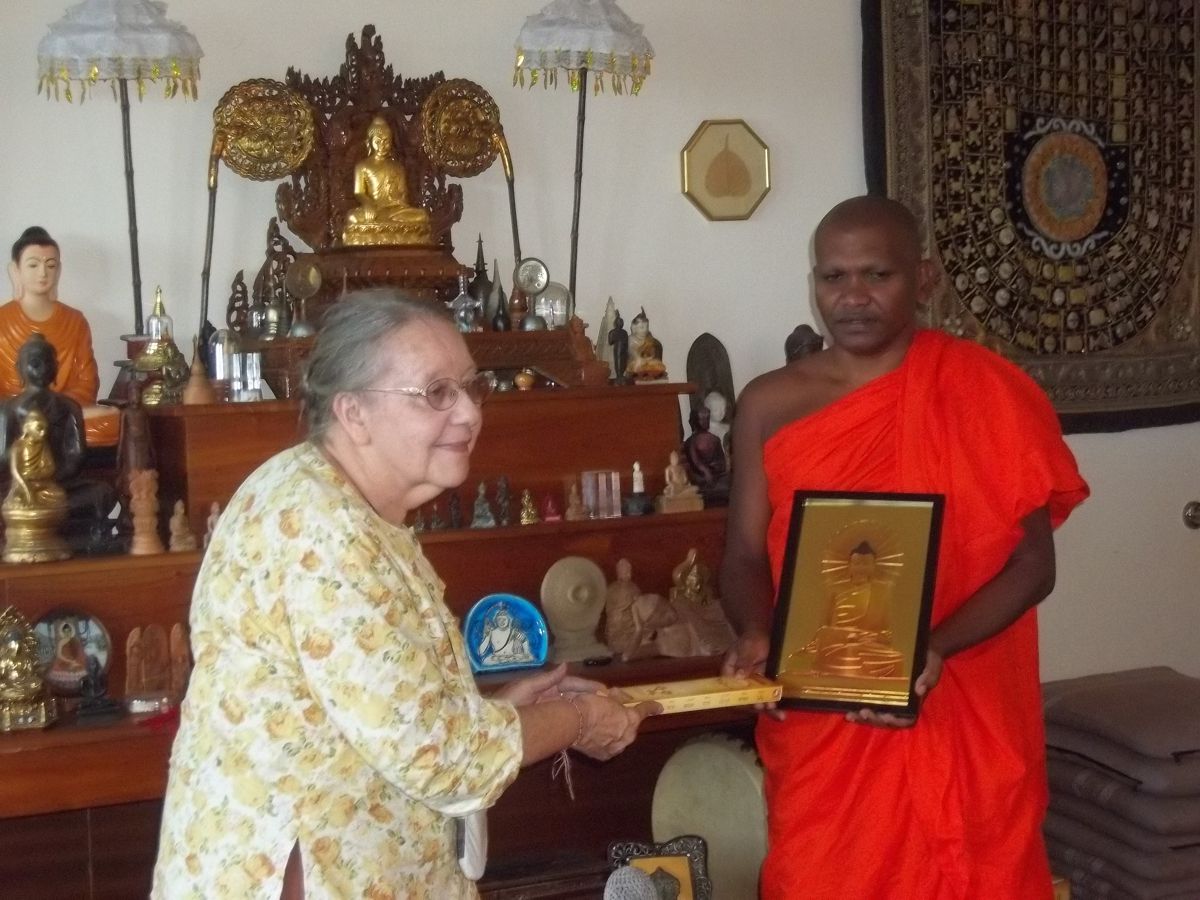 Ven. Amilasiri further informed us that Kurnegala STILL has no rain. All the rice in the district has withered and died. The wells have all run dry. The temple is still buying two bowsers of water every day, at a cost of LKR 12,000 ($80) per day, and that water, which comes from the lake, is not suitable for drinking. They are also buying bottled water. This has been going on for more than two months. Obviously, the situation is untenable. In order to continue caring for the elderly monks, Ven. Amilasiri is considering leaving Kurunegala and moving to Colombo. He has been offered a piece of land where water is readily available. The plot is large enough for a temple and a ward for the elderly monks. It is valued at LKR 5,000,000 ($33,000), but the owner has told Ven. Amilasiri that he can have it for LKR 1,500,000 ($10,000). Another donor has given a firm promise to donate LKR 3,000,000 ($20,000) for buildings, as soon as Ven. Amilasiri has the land--even tomorrow, he says. A few years ago, Buddhist Relief Mission made a similar appeal and many generous donors responded. Within a short time we were able to provide Ven. Amilasiri with enough money to purchase a small plot of land next to his temple which contained a well. That well contributed to the well-being of many monks over the years. Now the situation has changed, and the temple is once again in difficulty. We are once more appealing for donations to support both the resident monks and the elderly monks. We will, as always, promptly receipt all donations and provide regular updates on the progress of the project. Thank you very much for your assistance.
Ven. Amilasiri further informed us that Kurnegala STILL has no rain. All the rice in the district has withered and died. The wells have all run dry. The temple is still buying two bowsers of water every day, at a cost of LKR 12,000 ($80) per day, and that water, which comes from the lake, is not suitable for drinking. They are also buying bottled water. This has been going on for more than two months. Obviously, the situation is untenable. In order to continue caring for the elderly monks, Ven. Amilasiri is considering leaving Kurunegala and moving to Colombo. He has been offered a piece of land where water is readily available. The plot is large enough for a temple and a ward for the elderly monks. It is valued at LKR 5,000,000 ($33,000), but the owner has told Ven. Amilasiri that he can have it for LKR 1,500,000 ($10,000). Another donor has given a firm promise to donate LKR 3,000,000 ($20,000) for buildings, as soon as Ven. Amilasiri has the land--even tomorrow, he says. A few years ago, Buddhist Relief Mission made a similar appeal and many generous donors responded. Within a short time we were able to provide Ven. Amilasiri with enough money to purchase a small plot of land next to his temple which contained a well. That well contributed to the well-being of many monks over the years. Now the situation has changed, and the temple is once again in difficulty. We are once more appealing for donations to support both the resident monks and the elderly monks. We will, as always, promptly receipt all donations and provide regular updates on the progress of the project. Thank you very much for your assistance.